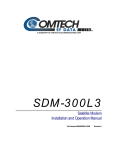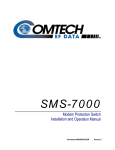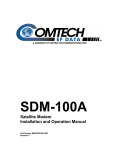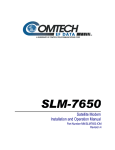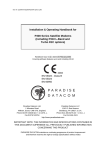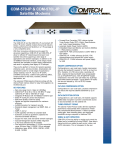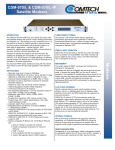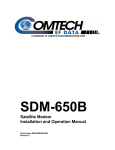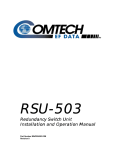Download SDM-300L SATELLITE MODEM
Transcript
SDM-300L Satellite Modem Operator’s Guide Part Number MN/SDM300L.OG Revision 2 SDM-300L Satellite Modem Operator’s Guide Comtech EFData is an ISO 9001 Registered Company. Part Number MN/SDM300L.OG Revision 2 November 6, 2000 Copyright © Comtech EFData, 2000. All rights reserved. Printed in the USA. Comtech EFData, 2114 West 7th Street, Tempe, Arizona 85281 USA, (480) 333-2200, FAX: (480) 333-2161. Customer Support Contact the Comtech EFData Customer Support Department for: • Product support or training • Information on upgrading or returning a product • Reporting comments or suggestions concerning manuals A Customer Support representative may be reached at: Comtech EFData Attention: Customer Support Department 2114 West 7th Street Tempe, Arizona 85281 USA 480.333.2200 (Main Comtech EFData Number) 480.333.4357 (Customer Support Desk) 480.333.2161 FAX or, E-Mail can be sent to the Customer Support Department at: [email protected] Contact us via the web at www.comtechefdata.com. 1. To return a Comtech EFData product (in-warranty and out-of-warranty) for repair or replacement: 2. Request a Return Material Authorization (RMA) number from the Comtech EFData Customer Support Department. 3. Be prepared to supply the Customer Support representative with the model number, serial number, and a description of the problem. 4. To ensure that the product is not damaged during shipping, pack the product in its original shipping carton/packaging. 5. Ship the product back to Comtech EFData. (Shipping charges should be prepaid.) For more information regarding the warranty policies, see Warranty Policy, p. ix. ii Rev. 2 Table of Contents CHAPTER 1. INTRODUCTION..................................................................................1–1 Overview ..................................................................................................................................................... 1–3 1.1 1.1.1 Available Options.................................................................................................................................... 1–3 1.1.2 Monitoring Features ................................................................................................................................ 1–3 1.1.3 Compatibility........................................................................................................................................... 1–4 1.2 Application Notes ....................................................................................................................................... 1–4 1.3 Specifications.............................................................................................................................................. 1–5 1.4 Dimensional Envelope ............................................................................................................................... 1–9 CHAPTER 2. INSTALLATION ...................................................................................2–1 2.1 Unpacking................................................................................................................................................... 2–1 2.2 Installation.................................................................................................................................................. 2–2 2.3 External Modem Connections................................................................................................................... 2–4 2.3.1 Remote Connector and Pinouts (J6) ........................................................................................................ 2–6 2.3.2 Fault Connector and Pinouts (J7) ............................................................................................................ 2–7 2.3.3 Data I/O Interface Connector (J8) ........................................................................................................... 2–8 2.3.4 Auxiliary 1 Connector and Pinouts (J9) ................................................................................................ 2–17 2.3.5 Alarms Connector and Pinouts (J10)..................................................................................................... 2–18 2.3.6 RF Output Connector (CP1) .................................................................................................................. 2–18 2.3.7 External Reference (CP2)...................................................................................................................... 2–18 2.3.8 RF Input Connector (CP3)..................................................................................................................... 2–19 2.3.9 AC Power Connector............................................................................................................................. 2–19 2.3.10 Ground Connector (GND) ..................................................................................................................... 2–19 Rev. 2 iii Preface SDM-300L Satellite Modem CHAPTER 3. OPERATION ........................................................................................3–1 3.1 Front Panel ................................................................................................................................................. 3–1 3.1.1 LED Indicators ........................................................................................................................................ 3–2 3.1.2 Front Panel Keypad ................................................................................................................................. 3–2 3.2 Menu System .............................................................................................................................................. 3–4 3.2.1 Code Rate and Data Rate Range.............................................................................................................. 3–5 3.2.2 Front Panel Menu .................................................................................................................................... 3–6 3.3 SDM-300L Custom Modem Defaults ..................................................................................................... 3–29 3.4 Custom Operation.................................................................................................................................... 3–32 APPENDIX A. OPTIONS........................................................................................... A–1 A.1 FAST Accessible Options ......................................................................................................................... A–1 A.1.1 FAST System Theory......................................................................................................................... A–2 A.1.2 Implementation .................................................................................................................................. A–3 A.2 iv Options....................................................................................................................................................... A–6 Rev. 2 SDM-300L Satellite Modem Preface Figures Figure 1-1. SDM-300L ............................................................................................................................................ 1–1 Figure 1-2. Block Diagram ...................................................................................................................................... 1–2 Figure 1-3. Dimensional Envelope Drawing............................................................................................................ 1–9 Figure 2-1. Installation of the Optional Mounting Bracket KT/6228-1 ................................................................... 2–3 Figure 2-2. Basic Modem, 25-Pin D Connector....................................................................................................... 2–5 Figure 2-3. (V.35) 34-Pin Winchester Connector .................................................................................................... 2–5 Figure 2-4. EIA-422/449, 37-Pin D Connector........................................................................................................ 2–5 Figure 2-5. Overhead Option, 50-Pin D Connector................................................................................................... 2–5 Figure 2-6. Data I/O Connector (J8) Removal/Installation .................................................................................... 2–16 Figure 3-1. Front Panel View................................................................................................................................... 3–1 Figure 3-2. Keypad .................................................................................................................................................. 3–2 Figure 3-3. Main Menu ............................................................................................................................................ 3–6 Figure 3-4. Configuration Modulator Menu ............................................................................................................ 3–7 Figure 3-5. Configuration Demodulator Menu ........................................................................................................ 3–8 Figure 3-6. Configuration Interface Menu ............................................................................................................... 3–9 Figure 3-7. Configuration Local AUPC Menu....................................................................................................... 3–11 Figure 3-8. Configuration MUX ............................................................................................................................ 3–12 Figure 3-9. Configuration Flex Mux ...................................................................................................................... 3–13 Figure 3-10. Configuration Save Menu.................................................................................................................. 3–15 Figure 3-11. Configuration Recall Menu ............................................................................................................... 3–15 Figure 3-12. Monitor Menu ................................................................................................................................... 3–16 Figure 3-13. Faults/Alarms Menu .......................................................................................................................... 3–17 Figure 3-14. Stored Faults/Alarms Menu............................................................................................................... 3–18 Figure 3-15. Remote AUPC Configuration Menu ................................................................................................. 3–19 Figure 3-16. Remote AUPC Monitor Menu........................................................................................................... 3–19 Figure 3-17. Utility Modulator Menu .................................................................................................................... 3–20 Figure 3-18. Utility Demodulator Menu ................................................................................................................ 3–21 Figure 3-19. Utility Interface Menu ....................................................................................................................... 3–22 Figure 3-20. Utility System Menu ......................................................................................................................... 3–24 Figure 3-21. Utility Modem Type Menu................................................................................................................ 3–26 Figure 3-22. Utility Factory Setup Menu ............................................................................................................... 3–28 Tables Table 1-1. SDM-300L Versions............................................................................................................................... 1–2 Table 1-2. Application Notes ................................................................................................................................... 1–4 Table 1-3. General Specifications ............................................................................................................................ 1–5 Table 2-1. Modem Rear Panel Connectors .............................................................................................................. 2–4 Table 2-2. Remote Connector and Pinouts (J6) ....................................................................................................... 2–6 Table 2-3. Fault Connector and Pinouts (J7)............................................................................................................ 2–7 Table 2-4. 25-Pin D Connector Pinouts ................................................................................................................... 2–9 Table 2-5. 34-Pin Winchester Connector Pinouts (V.35) ...................................................................................... 2–10 Table 2-6. 37-Pin Connector Pinouts (Optional).................................................................................................... 2–11 Table 2-7. 50-Pin Connector Pinouts ..................................................................................................................... 2–12 Table 2-8. AUX 1 Connector and Pinouts (J9) ...................................................................................................... 2–17 Table 2-9. Alarms Connector and Pinouts (J10) .................................................................................................... 2–18 Table 3-1. LED Indicators ....................................................................................................................................... 3–2 Table 3-2. SDM-300L Custom Modem Defaults................................................................................................... 3–29 Table A-1. FAST Options and Required Configurations........................................................................................ A–2 Rev. 2 v Preface SDM-300L Satellite Modem Overview of Changes to Previous Edition Chapter 3. Updated Menus to incorporate Firmware Version 2.1.2. About this Manual This manual provides installation and operation information for the Comtech EFData SDM-300L satellite modem. This is a technical document intended for earth station engineers, technicians, and operators responsible for the operation and maintenance of the SDM-300L. Related Documents The following documents are referenced in this manual: • Comtech EFData SDR-54 Satellite Demodulator Installation and Operation Manual • Comtech EFData SDM-300L Satellite Modem Technical Information Guide Note: The Technical Information Guide is available in electronic format on the Product Information CD included with the unit. vi • Comtech EFData UB-530 Universal Breakout Panel Installation and Operation Manual • Comtech EFData UB-54 Universal Breakout Panel Installation and Operation Manual • Comtech EFData Space Link Remote System User’s Guide Rev. 2 SDM-300L Satellite Modem Preface Conventions and References Cautions and Warnings CAUTION CAUTION indicates a hazardous situation that, if not avoided, may result in minor or moderate injury. CAUTION may also be used to indicate other unsafe practices or risks of property damage. WARNING indicates a potentially hazardous situation that, if not avoided, could result in death or serious injury. WARNING Metric Conversion Metric conversion information is located on the inside back cover of this manual. This information is provided to assist the operator in cross-referencing English to Metric conversions. Recommended Standard Designations Recommended Standard (RS) Designations have been superseded by the new designation of the Electronic Industries Association (EIA). References to the old designations are shown only when depicting actual text displayed on the screen of the unit (RS-232, RS485, etc.). All other references in the manual will be shown with the EIA designations (EIA-232, EIA-485, etc.) only. Trademarks Windows is a trademark of the Microsoft Corporation. Other product names mentioned in this manual may be trademarks or registered trademarks of their respective companies and are hereby acknowledged. Reporting Comments or Suggestions Concerning this Manual Comments and suggestions regarding the content and design of this manual will be appreciated. To submit comments, please contact the Comtech EFData Customer Support Department. Rev. 2 vii Preface SDM-300L Satellite Modem European Low Voltage Directive The following information is applicable for the European Low Voltage Directive (EN60950): <HAR> ! Type of power cord required for use in the European Community. CAUTION: Double-pole/Neutral Fusing ACHTUNG: Zweipolige bzw. Neutralleiter-Sicherung International Symbols: Alternating Current. Fuse. Safety Ground. Chassis Ground. Note: For additional symbols, refer to “Cautions and Warnings” listed earlier in this preface. viii Rev. 2 SDM-300L Satellite Modem Preface Warranty Policy This Comtech EFData product is warranted against defects in material and workmanship for a period of one year from the date of shipment. During the warranty period, Comtech EFData will, at its option, repair or replace products that prove to be defective. For equipment under warranty, the customer is responsible for freight to Comtech EFData and all related custom, taxes, tariffs, insurance, etc. Comtech EFData is responsible for the freight charges only for return of the equipment from the factory to the customer. Comtech EFData will return the equipment by the same method (i.e., Air, Express, Surface) as the equipment was sent to Comtech EFData. Limitations of Warranty The foregoing warranty shall not apply to defects resulting from improper installation or maintenance, abuse, unauthorized modification, or operation outside of environmental specifications for the product, or, for damages that occur due to improper repackaging of equipment for return to Comtech EFData. No other warranty is expressed or implied. Comtech EFData specifically disclaims the implied warranties of merchantability and fitness for particular purpose. Exclusive Remedies The remedies provided herein are the buyer's sole and exclusive remedies. Comtech EFData shall not be liable for any direct, indirect, special, incidental, or consequential damages, whether based on contract, tort, or any other legal theory. Disclaimer Comtech EFData has reviewed this manual thoroughly in order that it will be an easy-touse guide to your equipment. All statements, technical information, and recommendations in this manual and in any guides or related documents are believed reliable, but the accuracy and completeness thereof are not guaranteed or warranted, and they are not intended to be, nor should they be understood to be, representations or warranties concerning the products described. Further, Comtech EFData reserves the right to make changes in the specifications of the products described in this manual at any time without notice and without obligation to notify any person of such changes. If you have any questions regarding your equipment or the information in this manual, please contact the Comtech EFData Customer Support Department. Rev. 2 ix Preface SDM-300L Satellite Modem This page is intentionally blank. x Rev. 2 1 Chapter 1. INTRODUCTION This chapter provides an overview of the SDM-300L satellite modem, referred to in this manual as “the modem” (Figure 1-1). Note: An SDM-300L Technical Information Guide is available in electronic format on the CD included with the unit. It contains detailed information that is beyond the scope of this Operator’s Guide. Figure 1-1. SDM-300L The SDM-300L Digital Satellite Modem is a high performance, full duplex modem. The unit is available in two versions as described in Table 1-1. Rev. 2 1–1 Introduction SDM-300L Satellite Modem Table 1-1. SDM-300L Versions Type Transmit (TX) 70/140 MHz L-Band SDM-300L-1 SDM-300L-2 Receive (RX) L-Band L-Band Refer to Figure 1-2 for a system block diagram. Notes: 1. The UB-530 universal breakout panel (BOP) is an option for V.35, G703, EIA-232, and EIA-422. 2. When the modem is equipped with a 50-pin data I/O connector, the use of the BOP is required to interface the customer data connector to the modem. 3. Contact Comtech EFData for information concerning universal breakout panels. (Optional) Breakout Panel UB-530 AC Or Optional DC Prime Power AC Only Power Power Supply Supply Opt Opt ODU ODU Supply Supply Ext Ref CP2 ST Clock Tx IF CP1 Rx Data Note 1 Tx Data Encoder Encoder // Modulator Modulator Tx Clock User Data Data Data Interface Interface J8 Ref Ref Osc Osc Transmit Transmit RF RF Equipment Equipment Rx Clock I/Q AUX 1 OC-TTL Faults Form C Contacts Remote Port J9 AUX 1 AUX AUX 11 Demodulator Demodulator // Decoder Decoder Sat Clock Rx IF AGC J7 Fault Relays J10 Alarm Relays J6 Remote Port M&C M&C CP3 LNB LNB Note 2 Control / Status Notes: 1) Tx IF (L-Band only) Outputs a 10 MHz Reference and Optional ODU Voltage. 2) Rx IF Outputs LNB Voltage and 10 MHz Reference. SDM-300L Satellite Modem Figure 1-2. Block Diagram 1–2 Rev. 2 SDM-300L Satellite Modem 1.1 Introduction Overview The SDM-300L utilizes advanced technology and digital signal processing techniques. This design eliminates circuitry to perform modem signal processing, resulting in higher reliability. The following lists the unit's features: • • • • • • • • • 1.1.1 2.4 kbit/s to 4.375 Mbit/s Fully Accessible System Topology (FAST) Closed Network Capability Automatic Uplink Power Control (AUPC) Asynchronous (ASYNC) Channel Unit Overhead Reed-Solomon FAST Acquisition Built-In Test (With L-Band TX and RX only) OQPSK Available Options FAST is Comtech EFData’s exclusive feature that eliminates the need to acquire options before they are required. The following list reflects the options available via FAST implementation. • • Variable Data Rate Viterbi or Sequential Decoder OQPSK Asymmetrical Loop Timing • • • • G.703 Interface Concatenated Reed-Solomon Codec • ASYNC/AUPC Overhead with 50-pin D connector When additional features are required, they are added on site, using FAST access codes (Appendix A). For addition information, contact the Comtech EFData Customer Support department. 1.1.2 Monitoring Features The unit's monitoring features include: • • • • Rev. 2 Interface Loopback – at the MOD and DEMOD interface (Bi-directional) Baseband Loopback – at the data interface (Bi-directional) BER, Eb/N0 , Buffer Fill Percentage IF Loopback (Not available with 70/140 MHz TX IF) 1–3 Introduction 1.1.3 SDM-300L Satellite Modem Compatibility The SDM-300L is functionally compatible with many Comtech EFData modems. When properly configured, the unit will interoperate with the following Comtech EFData modems: • • • • • • • 1.2 SDM-100 SDM-100A SDM-300 SDM-300A SDM-650B SDM-6000 SDM-8000 Application Notes Refer to Table 1-2 for Application Notes that are applicable to the SDM-300L. Table 1-2. Application Notes Application Note P/N APN/FAST APN/ReedSol 1–4 Date 21 April 1999 21 April 1999 Title Fully Accessible System Topology “FAST” Reed-Solomon Concatenated Codes Rev. 2 SDM-300L Satellite Modem 1.3 Introduction Specifications Refer to Table 1-3 for general specifications. Table 1-3. General Specifications Digital Interface (Standard) Digital Data Rate Symbol Rate Modulation/Demodulation Plesiochronous Buffer Forward Error Correction (FEC) Data Scrambling External Reference Input External Reference Output Level (Sourcing) Rev. 2 Specification (Fully Enhanced) EIA-232, EIA-422, and V.35 (25-pin D) 2.4 kbit/s to 4.375 Mbit/s, in 1 bit steps Note: In some applications the practical lower data rate is typically 19.2 kbit/s or higher., depending upon the performance of equipment used in conjunction with the SDM-300L. These applications include the use of a BUC or a LNB. 4.8 ksym/s to 2.5 Msym/s BPSK 1/2 Rate QPSK 1/2, 3/4, and 7/8 rate OQPSK 1/2, 3/4, and 7/8 rate 2 to 99 msec, in 2 msec steps to 2.6 Mbit/s 32 to 262122 bit/s in 16 bit steps Viterbi, K =7, 1/2, 3/4, and 7/8 rate Sequential 1/2, 3/4, and 7/8 rate Reed-Solomon IESS-308 (V.35) or None EXT 1, EXT 5, EXT 10, and EXT 20 MHz 10 MHz, 0 to +10 dBm 1–5 Introduction SDM-300L Satellite Modem Table 1-3. General Specifications (Continued) Parameter Output Frequency Output Power Output Stability Output Spurious in 4 kHz Band (measured with modulated carrier) Output Phase Noise Output Impedance, Return Loss Output Spectrum Data Clock Source Internal Stability Output Connector Outdoor Reference (center conductor of IF Output connector) Outdoor Unit (ODU) DC Voltage (From IF output connector) Input Frequency Minimum Input Power (Desired Carrier) AGC Range Composite to Desired Carrier Maximum Composite Level Input Impedance, Return Loss Input Connector Carrier Acquisition Range Acquisition Time Sweep Reacquisition Buffer Clock LNB Voltage LNB Reference (Center Conductor or IF Input Connector) 1–6 Modulation Specification 70/140 MHz 50 to 90 and 100 to 180 MHz in 1 Hz steps +5 to –20 dBm in 0.1 dB steps ± 0.5 dB < -50 dBc, 20 to 500 MHz > 64 kbit/s < -45 dBc, 20 to 500MHz ≤ 64 kbit/s < -66 dBc/Hz at 100Hz < -76 dBc/Hz at 1 kHz < -86 dBc/Hz at 10 kHz < -96 dBc/Hz at 100 kHz < -96 dBc/Hz at 1 MHz 75Ω ≥ 20 dB IESS-308/-309, EFD Closed Internal or External ± 10 ppm BNC, Female Not Applicable Not Applicable L-Band Option 950 to 1750 MHz in 100 Hz steps 0 to –30 dBm in 0.5 dB steps, with ± 2.5 dB accuracy ± 0.5 dB < –50 dBc, 55 to 2000 MHz < -63 dBc/Hz at 100 Hz < -73 dBc/Hz at 1 kHz < -83 dBc/Hz at 10 MHz < -93 dBc/Hz at 100 kHz 50Ω ≥ 15 dB IESS-308/-309, EFD Closed Internal or External ± 0.02 ppm Type N, Female On or Off 10 MHz ± 0.02 ppm at 0 ± 3 dBm On or Off (with optional ODU voltage) Demodulation Specification 950 to 1750 MHz in 100 Hz steps +10 log (symbol rate) – 135 dBm 50 dB above minimum input level +40 dBc, ≥ 64 ksym/s +50 dBc, < 64 ksym/s –5 dBm 75Ω ≥ 10 dB Type N, Female ± 75 kHz in 1 Hz steps <1 second at 64 kbit/s 1/2 rate 0 to 999 seconds, in 1 second steps Internal, External, Transmit, Recovered RX On or Off +13 and +18 VDC per DiSEqC 4.2 and + 24VDC at 500 mA maximum On or Off 10 MHz ± 0.02 ppm at – 6 to +0 dBm Rev. 2 SDM-300L Satellite Modem Introduction Table 1-3. General Specifications (Continued) Prime Power Dimensions Weight Operating Temperature Humidity Serial Interface Signals Controlled or Monitored Configuration Retention Rev. 2 Environmental Specifications 90 to 264 VAC, 47 to 63 Hz 1.75 H x 19 W x 19.18 D inches (1 RU) (4.44 H x 48.26 W x 48.72 D cm) 12 lbs (5 kg) maximum 0 to 50°C (32 to 122°F) Up to 95% non-condensing Remote Control Specification EIA-232 or EIA-485 (2-/4-wire) Receive Frequency Terminal Frequency Transmitter On/Off Transmit Power Data Loopbacks Data Rate Select IF Loopback (L-Band) RF Loopback (L-Band) Raw Error Rate Scrambler (On/Off) Receive Signal Level Receive Carrier Detect Fault Status Power Supply Voltages Error Threshold Alarm Plesiochronous Buffer Field Upgradability Will maintain current configuration for at least 1 year without power. 1–7 Introduction SDM-300L Satellite Modem Table 1-3. General Specifications (Continued) Data Rate: 100 kbit/s Data Rate: 1.544 Mbit/s BER 10-5 10-6 10-7 10-8 BER 10-6 10-7 10-8 1–8 BER and Eb/No Performance Sequential Decoder BPSK (1/2 Only) QPSK and OQPSK BER 1/2 10-5 4.5 dB 5.4 dB 10-7 BER 1/2 10-5 5.6 dB 6.3 dB 10-7 Viterbi Decoder BPSK (1/2 Only) QPSK and OQPSK 3/4 1/2 5.3 dB 6.4 dB 6.0 dB 7.2 dB 6.6 dB 7.9 dB 7.2 dB 8.5 dB Concatenated Reed-Solomon Codes BPSK (1/2 Only) QPSK and OQPSK 3/4 1/2 4.1 dB 5.6 dB 4.2 dB 5.8 dB 4.4 dB 6.0 dB 3/4 5.5 dB 6.4 dB 3/4 6.1 dB 7.0 dB 7/8 6.6 dB 7.8 dB 7/8 6.9 dB 7.9 dB 7/8 7.6 dB 8.3 dB 8.9 dB 9.6 dB 7/8 6.7 dB 6.9 dB 7.1 dB Rev. 2 SDM-300L Satellite Modem 1.4 Introduction Dimensional Envelope Refer to Figure 1-3 for the unit’s dimensional envelope drawing. Note: Dimensions are listed in inches and centimeters are in parentheses. 19.18 (48.72) 1.75 (4.4) 19.0 (48.26) 17.0 (43.18) 1.25 (3.2) Figure 1-3. Dimensional Envelope Drawing Rev. 2 1–9 Introduction SDM-300L Satellite Modem This page is intentionally left blank. 1–10 Rev. 2 2 Chapter 2. INSTALLATION This chapter describes the installation and external connections for the SDM-300L unit. 2.1 Unpacking The modem and manual are packaged in pre-formed, reusable, cardboard cartons containing foam spacing for maximum shipping protection. Do not use any cutting tool that will extend more than 1 inch into the container and cause damage to the modem. CAUTION Unpack the modem: 1. 2. 3. 4. 5. 6. 7. Rev. 2 Cut the tape at the top of the carton indicated by OPEN THIS END. Remove the cardboard/foam space covering the modem and caddypacks. Remove the modem, caddypacks, manual, and power cord from the carton. Save the packing material for storage or reshipment purposes. Inspect the equipment for any possible damage incurred during shipment. Check the equipment against the packing list to ensure the shipment is correct. Refer to Section 2.2 for installation instructions. 2–1 Installation 2.2 SDM-300L Satellite Modem Installation The modem arrives fully assembled from the factory. After unpacking the modem, install the modem as follows: 2.2.1 IDU Installation (Optional) Refer to Figure 2-1. Use mounting kit KT/6228-1. Optional: Mounting Kit , KT/6228-1 (IDU to Equipment Rack) QTY 2 4 2 Part Number FP/6138-1 HW/10-32x1/2RK HW/10-32X1/4 SHC Description Bracket, Rear Support Bolt, #10 Rack Screw, Socket 10-32 x 1/4inch Tools Required: Screw Driver 5/32-inch Phillips SAE Allen Wrench 1. Install the IDU rear support brackets as follows: a. Install provided rear support bracket onto the mounting rail of the rack. Fasten with provided bracket bolts. b. Fasten the provided #10 socket head screws to the rear-side mounting holes on either side of the chassis modem. Mount the modem into the equipment rack ensuring that the socket heads engage into the slots of the rear support brackets. Note: It may be necessary to adjust the location of the rear mounting rails of the rack. 2–2 Rev. 2 SDM-300L Satellite Modem Installation Equipment Rack Mounting Rail * * #10 Socket head screw BRACKET BOLTS * Support Bracket * Note: Components of mounting kit KT/6228-1 IDU Figure 2-1. Installation of the Optional Mounting Bracket KT/6228-1 Rev. 2 2–3 Installation 2.3 SDM-300L Satellite Modem External Modem Connections When a breakout panel, such as the UB-530, is not required, the rear panel connectors provide all necessary external connections between the modem and other equipment. Table 2-1 lists these connectors, and Figure 2-2 through Figure 2-5 show their locations. Notes: 1. Refer to the Comtech EFData UB-530 Universal Breakout Panel Installation and Operation Manual for connecting the UB-300 breakout panel. 2. Refer to the Comtech EFData UB-54 Breakout Panel Installation and Operation Manual for connecting the UB-54 breakout panel in a MUX option configuration. Table 2-1. Modem Rear Panel Connectors Name TX/IF OUTPUT EXT REF RF IF INPUT REMOTE FAULT DATA I/O Ref. Desig. CP1 CP2 CP3 J6 J7 J8 Connector Type Function BNC (70/140 MHz) Type N (L-Band) BNC Type N 75Ω 9-pin D 9-pin D 25-pin D 34-pin 37-pin D 50-pin D AUX 1 J9 9-pin D ALARMS J10 9-pin D AC INPUT GROUND NONE NONE RF Output EXT REF IN RF Input Remote Interface FORM C Fault Relay Contacts Data Input/Output (standard modem) V.35 EIA-449 Data Input/Output (modem with ASYNC/AUPC/IDR/IBS option) (TTL) Faults Satellite Clock Demod I/Q Automatic Gain Control (AGC) Out FORM C Alarm Relay Contacts IEC 10-32 Stud Note: The European EMC Directive (EN55022, EN50082-1) requires using properly shielded cables for DATA I/O. These cables must be double-shielded from end-to-end, ensuring a continuous ground shield. 2–4 Rev. 2 SDM-300L Satellite Modem Installation J6 REMOTE EX REF J9 AUX 1 FAULT J7 ALARMS J10 TX/IF OUTP UT RX/IF INPUT CP3 CP2 CP1 Figure 2-2. Basic Modem, 25-Pin D Connector J6 REMOTE EX REF J9 AUX 1 FAULT J7 TX/IF OUTP UT RX/IF INPUT CP3 ALARMS J10 CP2 CP1 Figure 2-3. (V.35) 34-Pin Winchester Connector J6 REMOTE EX REF J9 AUX 1 FAULT J7 TX/IF OUTP UT RX/IF INPUT CP3 ALARMS J10 CP2 CP1 Figure 2-4. EIA-422/449, 37-Pin D Connector J6 REMOTE EX REF J9 AUX 1 FAULT J7 ALARMS J10 TX/IF OUTP UT RX/IF INPUT CP3 CP2 CP1 Figure 2-5. Overhead Option, 50-Pin D Connector Rev. 2 2–5 Installation SDM-300L Satellite Modem Remote Connector and Pinouts (J6) The remote connector is a 9-pin subminiature female D connector (J6) located on the rear panel of the modem. Screw locks are provided for mechanical security of the mating connector. The remote connector interfaces the M&C functions to a remote location. The remote location can be an M&C computer located away from the modem, but attached via cable to the remote connector. This DCE interface is user selectable for either EIA-232 or EIA-484. Refer to Table 2-2 for pinout information. Table 2-2. Remote Connector and Pinouts (J6) Pinout EIA-232 Pin # 1 2 3 4 5 6 7 8 9 Name RD (RX) TD (TX) GND DSR RTS CTS Pin # 1 2 3 4* 5* 6 7 8* 9* EIA-485 Name (2-Wire) GND Name (4-Wire) +RX/TX -RX/TX +TX -TX +RX/TX -RX/TX +RX -RX *For 2-Wire Operation: • Only two wires are required. • Tie pins 4 and 8 together (both +). • Tie pins 5 and 9 together (both -). 2–6 Rev. 2 SDM-300L Satellite Modem Installation Fault Connector and Pinouts (J7) The fault connector provides Form C contact closures for fault reporting. The three Form C summary fault contacts, ratings 1A maximum at 24 VDC, 0.5A at 120 VAC, are Modulator, Demodulator, and Common Equipment. The fault interface connection is a 9-pin subminiature female D connector (J7) located on the rear panel of the modem. Screw locks are provided for mechanical security on the mating connector. Refer to Table 2-3 for pinout information. Table 2-3. Fault Connector and Pinouts (J7) Pin # 1 2 3 4 5 6 7 8 9 Signal Function Common equipment is not faulted Common equipment is faulted Modulator is not faulted Modulator is faulted Demodulator is not faulted Demodulator is faulted Name NO COM NC NO COM NC NO COM NC Note: A connection between the common (COM) and normally open (NO) contacts indicates no fault. Rev. 2 2–7 Installation SDM-300L Satellite Modem Data I/O Interface Connector (J8) The Data I/O interface connector conducts data input and output signals to and from the modem, and connects to the customer’s terrestrial equipment, breakout panel, or protection switch. The modem is currently available with a choice of four Data I/O connectors, as follows: • 25-pin D connector is the standard connector shipped with a base platform modem. • 50-pin D connector is the standard connector when the modem is ordered with the optional overhead PCB or if the overhead PCB has been installed in the field. • 50-pin D that can be ordered with the basic modem, but it does not include the Overhead Card. This is used with breakout panels and switches. • 37-pin D is an alternate connector available upon special request for the base platform modem. • 34-pin Winchester is an alternate connector available upon special request for the base platform modem. The Data I/O pinout is different for each of the interface configurations. For pinout information, refer to the appropriate table as follows: Standard: 25-pin D connector Optional: 34-pin Winchester connector Optional: 37-pin D connector Optional: 50-pin D connector 2–8 Table 2-4 Table 2-5 Table 2-6 Table 2-7 Rev. 2 SDM-300L Satellite Modem Installation Table 2-4. 25-Pin D Connector Pinouts Pin # 1 2 3 4 5 6 7 8 9 10 11 12 13 14 15 16 17 18 19 20* 21 22 23* 24 25 EIA-422 SHLD SD-A RD-A RS-A CS-A DM-A SIGGND RR-A RT+B RR-B TT+B ST+B CS+B SD+B ST-A RD+B RT-A LL RS+B MC-A DF DM+B MC+B TT-A MF 25-Pin D Connector EIA-232 SHLD TXD RXD RTS CTS DSR SIGGND DCD V.35 SHLD SD-A RD-A RTS CTS DSR SIGGND RLSD SCR+B SCTE+B SCT+B RXC LL SD+B SCT-A RD+B SCR-A LL MC DF MC-A DF TXC MF MC-B SCTE-A MF ST *Note: Use the MASTER clock for EXTERNAL clock input. This clock input should equal the data rate unless the Asymmetrical Loop Timing Option (ASLT) is available. The ASLT option allows selection of different clock rates that vary from the digital data rate. Refer to the Utility/Modem Type/Modem Options menu for the ASLT option information. Rev. 2 2–9 Installation SDM-300L Satellite Modem Table 2-5. 34-Pin Winchester Connector Pinouts (V.35) Pin # A B C D E F P R S T U V W X Y c (CC) d (DD) m (MM) n (NN) a(AA) Name SIGGND SHLD Request to Send (RTS) Clear to Send (CTS) Data Set Ready (DSR) Receive Line Signal Detect (RLSD) Send Data A (SD-A) Receive Data A (RD-A) Send Data B (SD+B) Receive Data B (RD+B) Serial Clock Transmit External A (SCTE-A) Serial Clock Receive A (SCR-A) Serial Clock Transmit External B (SCTE+B) Serial Clock Receive B (SCR+B) Serial Clock Transmit A (SCT-A) MC-A MC-B Modulator Fault (MF) Demodulator Fault (DF) Serial Clock Transmit B (SCT+B) Note: Pins H, J, K, L, M, N, Z, a (AA), b (BB), e (EE), f (FF), h (HH), j (JJ), k (KK), l (LL) have no connection. The modem is available with a Winchester V.35 as the data I/O connector (PL/6032). There is a jumper on the unit that either opens or closes the CC line. The interface is shipped with jumpers in positions 2 and 3, because: 1. Comtech EFData has determined that several locations use Fireberd test equipment and a conflict will occur if CC is connected between the modem and the Fireberd. 2. Placing the jumper in positions 2 and 3 opens up the CC line, because the TTC/Fireberd test equipment interfaces use the line for DTE/DCE control. 3. Grounding pin CC at the Fireberd interface will change the Fireberd to a DCE device. 4. Comtech EFData uses the CC and DD for the input master clock (same as the external clock input to the modem). To input an external clock, change the jumper to positions 1 and 2 (the pin closest to the Winchester connector). 2–10 Rev. 2 SDM-300L Satellite Modem Installation Table 2-6. 37-Pin Connector Pinouts (Optional) Pin # 1, 19 3 4 5 6 7 8 9 11 13 16 17 20, 37 21 22 23 24 25 26 27 29 31 34 35 EIA-422/MIL-188-144 Shield MF SD-A ST-A RD-A RS-A RT-A CS-A DM-A RR-A MC-A TT-A SIGGND DF SD+B ST+B RD+B RS+B RT+B CS+B DM+B RR+B MC+B TT+B There are jumpers on the PL/6031 EIA-422 interface. Place the jumpers on the center pin and the pin towards the Master Clock (MC) to allow an external clock input on pins 16 and 34. If desired, place the jumpers on the TR side to allow an external clock input on pins 12 and 30. Place the jumpers on the TR side for Demand Assigned Multiple Access (DAMA) applications. Rev. 2 2–11 Installation SDM-300L Satellite Modem Table 2-7. 50-Pin Connector Pinouts Pin # 1 2 3 4 5 2–12 IDR GND GND AGC Out EIA-422 TXOctA In EIA-422 TXOctB In 6 EIA-422 RXOctA Out 7 EIA-422 RXOctB Out 8 9 10 11 12 13 14 15 16 17 18 19 20 21 22 23 24 25 26 27 28 29 30 31 32 33 34 35 36 37 38 39 40 41 42 43 44 45 46 47 48 49 50 BWO1_C BWO2_C BWO3_C BWO4_C BWAI 1 BWAI 2 BWAI 3 BWAI 4 Demod Fault C Def Maint Alrm G.703 SDB In EIA-422 ExtClkB In G.703 RDB Out EIA-422 8k TClkA Out EIA-422 8k TClkB Out EIA-422 8k RClkA Out EIA-422 8k RClkB Out BWO1_NC BWO2_NC BWO3_NC BWO4_NC Aud1-B In (or 64SDB) Aud1-B Out (or 64RTB) Aud2-B In (or 64STB) Aud2-B Out (or 64RDB) DF G.703 SDA In EIA-422 ExtClkA In G.703 RDA Out EIA-422 8k TXDA In EIA-422 8k TXDB In EIA-422 8k RXDA Out EIA-422 8k RXDB Out BWO1_NO BWO2_NO BWO3_NO BWO4_NO Aud1-A In (or 64SDA) Aud1-A Out (or 64RTA) Aud2-A In (or 64STA) Aud2-A Out (or 64RDA) MF Demod Fault NO 50-Pin D Connector IBS Async GND GND GND GND AGC Out AGC Out ESC TXDB In (EIA-485 only) ESC TXDA In ESC TXDA In (EIA-232 only) (EIA-485 and EIA-232) ESC RXDB Out (EIA-485 only) ESC RXDA Out ESC RXDA Out (EIA-232 only) (EIA-485 and EIA-232) EIA-422 RX Oct A EIA-422 RX Oct B PRIMARY_C SECONDARY_C V.35/EIA-422 SCTE/TT-A V.35/EIA-422 SCTE/TT A V.35/EIA-422 SCTE/TT-B V.35/EIA-422 SCTE/TT B EIA-422 TX Oct A EIA-422 TX Oct B G.703 SDB In V.35/EIA-422 EXCB In G.703 RDB Out V.35/EIA-422 ST-A Out V.35/EIA-422 ST-B Out V.35/EIA-422 RT-A Out V.35/EIA-422 RT-B Out ESC TCLK Out (EIA-232) ESC RCLK Out (EIA-232) PRIMARY_NC SECONDARY_NC V.35/EIA-422 RTS-B V.35 RLSD/EIA-422 RR-B V.35/EIA-422 CTS-B V.35 DSR/EIA-422 DM-B G.703 SDB In V.35/EIA-422 EXCB In G.703 RDB Out V.35/EIA-422 ST-A Out V.35/EIA-422 ST-B Out V.35/EIA-422 RT-A Out V.35/EIA-422 RT-B Out G.703 SDA In V.35/EIA-422 EXCA In G.703 RDA Out V.35/EIA-422 SD-A In V.35/EIA-422 SD-B In V.35/EIA-422 RD-A Out V.35/EIA-422 RD-B Out ESC DSR (EIA-232) G.703 SDA In V.35/EIA-422 EXCA In G.703 RDA Out V.35/EIA-422 SD-A In V.35/EIA-422 SD-B In V.35/EIA-422 RD-A Out V.35/EIA-422 RD-B Out PRIMARY_NO SECONDARY_NO V.35/EIA-422 RTS-A V.35 RLSD/EIA-422 RR-A V.35/EIA-422 CTS-A V.35 DSR/EIA-422 DM-A D&I GND GND AGC Out ESC TXD In (EIA-232 only) ESC RXD Out (EIA-232 only) PRIMARY_C SECONDARY_C G.703 SDB In EIA-422 EXCB In G.703 RDB Out PRIMARY_NC SECONDARY_NC V.35/EIA-422 RTS-B V.35 RLSD/EIA-422 RR-B V.35/EIA-422 CTS-B V.35 DSR/EIA-422 DM-B G.703 SDA In EIA-422 EXCA In G.703 RDA Out G.703 DDO-A Out G.703 DDO-B Out G.703 IDI-A In G.703 IDI-B In PRIMARY_NO SECONDARY_NO V.35/EIA-422 RTS-A V.35 RLSD/EIA-422 RR-A V.35/EIA-422 CTS-A V.35 DSR/EIA-422 DM-A ESC DSR (EIA-232 only) Rev. 2 SDM-300L Satellite Modem Installation Notes: 1. IDR configuration connector pinouts: a. Backward alarm relay contacts are named for normal no fault conditions (BWOx-C connected to BWOx-NC if no fault). b. Backward alarm inputs should be grounded or pulled logic low to clear the alarm. c. Signals MF, DF, and DMA are open-collector, high-impedance (if faulted). MF and DF are used by a backup protection switch if the modem is used in a redundant system. d. Relay contacts DF-C and DF-NO are named for faulted condition (DFC connected to DF-NO, unless demodulator [Demod] fault). 2. D&I/ASYNC interface connector pinouts: a. With regard to alarm relay contacts, COMM is connected to NO when there is no fault. COMM is connected to NC in a faulted condition. b. Signals MF, DF, and DMA are open-collector, high-impedance (if faulted). MF and DF are used by a backup protection switch if the modem is used in a redundant system. 3. The breakout panel provides the external connections between the modem and the terrestrial equipment when the modem has a 50-pin connection. Rev. 2 2–13 Installation 2.3.1.1 SDM-300L Satellite Modem Data I/O Interface Connector (J8) Removal/Installation Note: The following procedures outline the removal and installation of the Data I/O connector (J8). These procedures are written with the assumption that the same configured connector will be reinstalled. However, the operator does have an option to install a different configured connector. Refer to Table 2-8 for a matrix explaining connector options. Table 2-8. Connector (J8) Matrix Modem Configuration 25-pin Connector 34-pin Connector 37-pin Connector 50-pin Connector 2.3.1.1.1 EIA-232 X EIA-422/EIA449 X X X X V.35 X X Overhead X X Data I/O Connector (J8) Removal 1. (For Ribbon-Configured Connector PL/6031.) Remove Data I/O connector (J8) (Figure 2-6) as follows: a. Remove four screws securing the rear panel to the chassis. b. Pull out rear panel to gain access to disconnect connector (J8). c. Disconnect connector (J8) from the PCB. d. Remove the four screws securing connector (J8) to the rear panel. e. Remove the connector (J8). 2. Remove 50-pin Data I/O connector (J8) as follows: a. Remove the four screws securing the connector (J8) to the rear panel. b. Establish a grip on connector (J8) and pull backwards until separation of the connectors is obtained. c. Remove connector (J8). 2–14 Rev. 2 SDM-300L Satellite Modem 2.3.1.1.2 Installation Data I/O Connector (J8) Installation 1. (For Ribbon-Configured Connector PL/6031.) Install Data I/O connector (J8) (Figure 2-6) as follows: a. Position connector (J8) in rear panel. CAUTION Use care when connecting the data I/O connector (J8) to the PCB. Damage to the connector pins may render the data I/O connector (J8) unserviceable. Misalignment can be the result. b. Connect connector (J8) to the PCB. c. Secure connector (J8) to the rear panel with four screws. d. Position the rear panel to mate with the chassis and secure with four screws. 2. Install 50-pin Data I/O connector (J8) as follows: CAUTION Use care when connecting the Data I/O connector (J8) to the PCB. Damage to the connector pins may render the data I/O connector (J8) unserviceable. Misalignment can be the result. a. Connect connector (J8) to the PCB. b. Secure connector (J8) using four screws. Rev. 2 2–15 Installation SDM-300L Satellite Modem For Ribbon-Configured Connector For 50-Pin Connector with Overhead Interface Board Figure 2-6. Data I/O Connector (J8) Removal/Installation 2–16 Rev. 2 SDM-300L Satellite Modem Installation Auxiliary 1 Connector and Pinouts (J9) The auxiliary 1 (AUX 1) connector provides: • • • • MOD and DEMOD (TTL) faults Satellite clock Satellite I&Q Automatic Gain Control (AGC) output voltage The faults are open collector levels that indicate a modulator or demodulator failure. A logic “1” indicates the faulted condition. AGC_OUT is a programmable voltage, 0 to 10V, for a receive signal level between -25 and -60 dBm. AUX 1 connection is a 9-pin female D connector (J9) located on the rear panel of the modem. Screw locks are provided for mechanical security on the mating connector. Refer to Table 2-9 for pinout information. Table 2-9. AUX 1 Connector and Pinouts (J9) Pin # 1 2 3 4 5 6 7 8 9 Rev. 2 Signal Function Satellite Clock No Connection Satellite Clock + MODULATOR TTL Fault Ground RX_Q DEMODULATOR TTL Fault RX 1 Channel Eye AGC Output Name SAT_CLKNC SAT_CLK+ MDFLTTTL GRN RX Q Channel Eye RX_1 AGC 2–17 Installation SDM-300L Satellite Modem Alarms Connector and Pinouts (J10) The alarm connector provides Form C contact closures for alarm reporting. The two Form C summary fault contacts are Modulator and Demodulator. The alarm connection is a 9-pin female D connector (J10) located on the rear panel of the modem. Screw locks are provided for mechanical security on the mating connector. Refer to Table 2-10 for pinout information. Table 2-10. Alarms Connector and Pinouts (J10) Pin # 1 2 3 4 5 6 7 8 9 • • • Signal Function Alarm 1 is faulted Alarm 1 is not faulted Alarm 2 is faulted Alarm 2 is not faulted Alarm 3 is faulted Alarm 3 is not faulted Name NO COM NC NO COM NC NO COM NC Alarm 1 = Not used Alarm 2 = TX Alarm 3 = RX RF Output Connector (CP1) 2–18 70/140 MHz Configuration CP1 is a BNC connector for the TX IF signal. The output impedance is 75Ω and the output return loss is ≥ _20 dB. In normal operation, the output will be a QPSK (Optional: OQPSK) or BPSK modulated result of the Data I/O connector between 50 and 180 MHz, in 1 Hz steps. L-Band Configuration CP1 is a Type N connector for the TX IF signal. The output impedance is 50Ω and the output return loss is ≥ -15 dB. In normal operation, the output will be a QPSK (Optional: OQPSK) or BPSK modulated result of the Data I/O connector between 950 to 1750 MHz, in 100 Hz steps. Rev. 2 SDM-300L Satellite Modem Installation External Reference (CP2) CP2 is a BNC connector for an EXT REF. The input impedance is 75Ω. For normal operation, the desired carrier signal level is ≥ 0 dB. EXT REF frequencies are EXT 1, EXT 5, EXT 10, and EXT 20 MHz. RF Input Connector (CP3) CP3 is a Type N connector for an RX IF signal. The input impedance is 75Ω (Optional: 50Ω). And the input return loss is ≥ 10 dB from 950 to 1750 MHz. AC Power Connector A standard, detachable, non-locking, 3-prong power cord (IEC plug) supplies the Alternating Current (AC) power to the modem. Observe the following: Input Power Input Voltage Connector Type Fuse Protection 55W maximum, 40W typical 90 to 132 or 175 to 264 VAC Unit switches ranges automatically I.E.C 1A slo-blo Line and neutral fusing 5 mm type fuses Ground Connector (GND) A #10-32 stud on the rear panel of the modem is used for connecting a common chassis ground among all equipment. Note: The AC power connector provides the safety ground. Rev. 2 2–19 Installation SDM-300L Satellite Modem This page is intentionally left blank. 2–20 Rev. 2 3 Chapter 3. OPERATION This chapter describes the operation of the SDM-300L using the front panel menus. 3.1 Front Panel The modem front panel (Figure 3-1) enables control of modem configuration parameters and displays the modem status. Figure 3-1. Front Panel View The front panel features include: • • • 32-character, 2-line LCD display 6-button keypad for local control 10 LEDs to provide overall status at a glance All functions are accessible at the front panel by entering one of six pre-defined Function Select categories or levels: • • • • • • Rev. 2 Configuration Monitor Faults/Alarms Stored Faults/Alarms Remote AUPC (ASYNC mode only) Utility 3–1 Operation 3.1.1 SDM-300L Satellite Modem LED Indicators The 10 LEDs on the front panel indicate: • • • General modem summary faults Status Alarms The indicators are defined in Table 3-1 as follows: Table 3-1. LED Indicators Name 3.1.2 LED Transmit Receive Common Stored Red Red Red Yellow Power On Transmitter On Green Green Carrier Detect Test Mode Green Yellow Transmit Receive Yellow Yellow Description Faults A fault condition exists in the transmit chain. A fault condition exists in the receive chain. A common equipment fault condition exists. A fault has been logged and stored. The fault may or may not be active. Status Power is applied to the modem. Transmitter is currently on. This indicator reflects the actual condition of the transmitter, as opposed to the programmed condition. Decoder is locked. Flashes when the modem is in a test configuration. Alarms A transmit function is in an alarm condition. A receive function is in an alarm condition. Front Panel Keypad The front panel keypad permits local operation of the modem. The keypad consists of six keys (Figure 3-2). ENTER CLEAR Figure 3-2. Keypad 3–2 Rev. 2 SDM-300L Satellite Modem Operation Each key provides one or more logical functions. These functions are defined in the following table. ENTER CLEAR Left and Right Diamond Keys Top and Bottom Diamond Keys This key is used to select a displayed function or to execute a modem configuration change. This key is used to back out of a selection or to cancel a configuration change which has not been executed using [ENTER]. Pressing [CLEAR] generally returns the display to the previous selection. These keys are used to move to the next selection or to move the cursor functions. Note: Throughout this chapter, [←] and [→] are used to indicate left and right diamond keys. These keys are used primarily to change configuration data (numbers). At times, they are also used to move from one section to another. Note: Throughout this chapter, [↑] and [↓] are used to indicate top and bottom diamond keys. The modem responds by beeping whenever a key is pressed: Rev. 2 • A single beep indicates a valid entry and the appropriate action was taken. • A double beep indicates an invalid entry or a parameter is not available for operation. 3–3 Operation 3.2 SDM-300L Satellite Modem Menu System Note: The menus show features and options that are not available. However, they are shown to preserve the menu structure and reserve the structure for the future. This does not imply an intent or obligation to add these features or options in the future. To access and execute all functions, refer to Figure 3-3 through Figure 3-22. Use the Main menu in Figure 3-3 as a quick reference for accessing the modem functions. When the modem power is applied, the base level of the menu system displays the sign-on message: • • Line 1 of the sign-on message is the modem model number and type. Line 2 is the version number of the firmware. The main level of the menu system is Function Select. To access this level from the sign-on message, press the [←] or [→] keys. From the Function Select menu; select one of the functional categories: • • • • • • Configuration Monitor Faults/Alarms Stored Faults/Alarms Remote AUPC (ASYNC mode only) Utility Press [←] or [→] to move from one selection to another. When line 2 displays the desired function, select that level by pressing [ENTER]. After entering the appropriate functional level, press [←] or [→] to move to the desired function. To view or change the modem’s configuration, enter the Configuration level from the Function Select menu. Once in the Configuration menu, press [←] or [→] to scroll through the Configuration menu selection: • • • • • • • Modulator Demodulator Interface Local AUPC (ASYNC Mode or Local Modem AUPC only) MUX (Optional) Save Recall Press [ENTER] to select the desired Configuration menu option. To view the options for the selected configuration parameters, press [←] or [→]. To change a configuration parameter, press [ENTER] to begin the change process. 3–4 Rev. 2 SDM-300L Satellite Modem Operation Press [↑] or [↓] to change the parameters. After the display represents the correct parameters, press [ENTER] to execute the change. This action initiates the necessary programming by the modem. To undo a parameter change prior to execution, press [CLEAR]. Notes: 1. Figure 3-3 list the front panel menu window selections. 2. ComTech EFdata recommends that selection of the desired Modem Type be made prior to making any other setting. This procedure is located in the Utility Modem Type menu. 3. Menus or commands that are specific to certain modem configurations are only accessible after selecting the appropriate modem configuration. This prevents incompatible parameters from accidentally being selected. 4. All of the windows are accessible in the Custom mode. Take caution not to select incompatible parameters, as the modem does not shut out incompatible command choices in the Custom mode. 3.2.1 Code Rate and Data Rate Range The following code rates and data rate range apply to the SDM-300L. Code Rate BPSK 1/2 QPSK 1/2 QPSK 3/4 QPSK 7/8 OQPSK 1/2 OQPSK 3/4 OQPSK 7/8 BPSK 1/1 QPSK 1/1 Data Rate Range 2.4 to 1250 kbit/s 4.8 to 2500 kbit/s 7.2 to 3750 kbit/s 8.4 to 4375 kbit/s 4.8 to 2500 kbit/s 7.2 to 3750 kbit/s 8.4 to 4375 kbit/s 4.8 to 2500 kbit/s 9.6 to 5000 kbit/s Note: In some applications the practical lower data rate is typically 19.2 kbit/s, or higher, depending upon the performance of equipment used in conjunction with the SDM-300L. These applications include the use of a BUC or an LNB. Rev. 2 3–5 Operation 3.2.2 SDM-300L Satellite Modem Front Panel Menu Non TX/RX L-Band Modem Only FUNCTION SELECT MONITOR SDM300L-1 ""TYPE" VER: 2.1.2 FUNCTION SELECT FAULTS/ALARMS or SDM300L-2 ""TYPE" VER: 2.1.2 FUNCTION SELECT STORED FLTS/ALMS TX/RX L-Band Modem Only FUNCTION SELECT REMOTE AUPC FUNCTION SELECT UTILITY CONFIGURATION MODULATOR REMOTE AUPC CONFIGURATION UTILITY MODULATOR CONFIGURATION DEMODULATOR REMOTE AUPC MONITOR UTILITY DEMODULATOR FUNCTION SELECT CONFIGURATION CONFIGURATION INTERFACE CONFIGURATION LOCAL AUPC CONFIGURATION MUX UTILITY INTERFACE Note: The menus show features and options that are not available. However, they are shown to preserve the menu structure and reserve the structure for the future. This does not imply an intent or obligation to add these features or optionsin the future. UTILITY SYSTEM UTILITY MODEM TYPE UTILITY FACTORY SETUP CONFIGURATION FLEX MUX CONFIGURATION SAVE Key: ACCESS TO SUBMENU CONFIGURATION RECALL CONDITIONAL OR OPTIONDEPENDENT Parameter Information Figure 3-3. Main Menu 3–6 Rev. 2 SDM-300L Satellite Modem SDM300L "TYPE" VER: X.X.X TX-X QPSK 1/2 Refer to Para 3.6 TX-IF OUTPUT ON OFF Operation FUNCTION SELECT CONFIGURATION CONFIGURATION MODULATOR TX-IF FREQUENCY TX-IF FREQUENCY TX TERMINAL FREQUENCY 50 to 180 MHz (in 1 Hz steps) NonTX/RX L-Band Modem Only 950 to 1750 MHz (in 100 Hz steps) TX/RX L-Band Modem Only 10950 to 12750 MHz (Range dependent on LNB selection, LO and MIX, in 100 Hz steps) TX POWER LEVEL TX POWER LEVEL -5.0 to -30.0 dBm (normal range) +5.0 to -20 dBm (high power option) NonTX/RX L-Band Modem Only SCRAMBLER ON OFF 0 to -30.0 dBm TX/RX L-Band Modem Only DIFFERENTIAL ENCODER CARRIER MODE MODEM REFERENCE ON OFF NORMAL-MODULATED CENTER-CW OFFSET-CW DUAL-CW INTERNAL EXT 1 MHz EXT 5 MHz EXT 10 MHz EXT 20 MHz ODU POWER ON OFF TX/RF L-Band Only OUTPUT 10 MHz (High Stability Option Only) ODU VOLTAGE ODU REFERENCE RS ENCODER 13, 18, or 24 VDC TX/RF L-Band Modem Only ON OFF TX/RF L-Band Modem Only ON OFF Reed-Solomon only Key: ACCESS TO SUBMENU CONDITIONAL OR OPTION-DEPENDENT Parameter Information Figure 3-4. Configuration Modulator Menu Rev. 2 3–7 Operation SDM-300L Satellite Modem SDM300L "TYPE" VER: X.X.X RX-X QPSK 1/2 Refer to para 3.6 DIFFERENTIAL DECODER ON OFF FUNCTION SELECT CONFIGURATION RX-IF FREQUENCY 950 to 1750 MHz (in 100 Hz steps) IF LOOPBACK CONFIGURATION DEMODULATOR RX TERMINAL FREQUENCY BER THRESHOLD SWEEP RANGE REACQUISITION LNB POWER 0 to 150,000 Hz 0 to 999 Seconds ON OFF ON OFF CORRECTION_OFF SWEEP CENTER None 1.0 E-X (X = 3 to 8) RS DECODER ON OFF 10950 to 12750 MHz (Range dependent on LNB selection, LO and MIX, in 100 Hz steps) ON OFF TX/RX L-Band Only LNB 10 MHz REF DESCRAMBLER -75,000 to +75,000 Hz LNB VOLTAGE ON OFF 13, 18, or 24 VDC Key: ACCESS TO SUBMENU CONDITIONAL OR OPTION-DEPENDENT Parameter Information (Reed-Solomon only) Figure 3-5. Configuration Demodulator Menu 3–8 Rev. 2 SDM-300L Satellite Modem SDM300L "TYPE" VER: X.X.X Operation FUNCTION SELECT CONFIGURATION TX CLOCK SOURCE TX CLOCK PHASE TX TERRESTRIAL SCT (INTERNAL EXT. CLOCK AUTO NORMAL INVERT CONFIGURATION INTERFACE EXT-CLK FREQ BUFFER CLOCK RX (SATELLITE) SCT (INTERNAL) EXT. CLOCK TX TERRESTRIAL INSERT CLOCK 8kHz to 10 MHz Note: EXT CLK: TX data rate and EXT-CLK FREQ must match or ASLT option installed. BUFFER SIZE BUFFER CENTER RX CLOCK PHASE B-BAND LOOP BACK 32 to 262144 bit/s (16 bit steps) 1 to 9 mS 0 (Bypass) Yes No NORMAL INVERT ON OFF LOOP TIMING TX DATA FAULT RX DATA FAULT OFF ON NONE AIS DATA Overhead only NONE AIS DATA Overhead only TX CODING FORMAT RX CODING FORMAT AMI B8ZS HDB3 AMI B8ZS HDB3 TX G.703 only RX G.703 only INTERFACE LOOPBACK OFF ON Overhead/RS only Note: TX/RX data rate must matchorASLT option installed. TX 2047 PATTERN RX 2047 PATTERN ON OFF ON OFF B Key: ACCESS TO SUBMENU CONDITIONAL OR OPTION-DEPENDENT Parameter Information Figure 3-6. Configuration Interface Menu Rev. 2 3–9 Operation SDM-300L Satellite Modem B CONFIGURATION INTERFACE continued SERVICE CHANNEL ADJUST DROP FORMAT CHANNEL: TX-1 CHANNEL: TX-2 CHANNEL: RX-1 CHANNEL: RX-2 Level = +10 to -20 dBm IDR only E1_CCS E1_CAS T1 T1_ESF TX D&I overhead only INSERT CHANNEL ASSIGNMENTS INSERT SAT CHANNEL TERR (T1, T1_EST, T1_S, T1_EST_S FORMATS) INSERT SAT T-SLOT TERR (ALL OTHER FORMATS) RX D&I only ASYNC RX LENGTH 5 BITS 6 BITS 7 BITS 8 BITS RX ASYNC only ASYNC RX PARITY E1_IBS E1_31_TS T1 T1_IBS T1_S T1_ESF_S RX D&I overhead only ASYNC TX BAUD ASYNC RX BAUD BAUD RATES (bit/s) 110 150 300 600 1200 2400 4800 9600 19200 38400 TX ASYNC only BAUD RATES (bit/s) 110 150 300 600 1200 2400 4800 9600 19200 38400 RX ASYNC only ASYNC TX STOP 1 BITS 2 BITS TX ASYNC only DROP CHANNEL ASSIGNMENTS INSERT FORMAT DROP SAT (T1, T1_ESF, T1_S, T1_EST_S FORMATS) CHANNEL TERR DROP SAT T-SLOT TERR (ALL OTHER FORMATS) TX D&I overhead only ASYNC TX LENGTH 5 BITS 6 BITS 7 BITS 8 BITS TX ASYNC only ASYNC RX STOP ASYNC TX PARITY 1 BITS 2 BITS RX ASYNC only EVEN ODD NONE TX ASYNC only Key: ACCESS TO SUBMENU CONDITIONAL OR OTION-DEPENDENT Parameter Information EVEN ODD NONE RX ASYNC only Figure 3-6. Configuration Interface Menu (Continued) 3–10 Rev. 2 SDM-300L Satellite Modem SDM300L "TYPE" VER: X.X.X AUPC ENABLE ON OFF Operation FUNCTION SELECT CONFIGURATION CONFIGURATION LOCAL AUPC (AUPC option only) NOMINAL POWER -5.0 to -30.0 dBm (In 0.5 dBm steps) [0 to -40.0 TX/RX L-Band Only] MINIMUM POWER MAXIMUM POWER -5.0 to -30.0 dBm (In 0.5 dBm steps) [0 to -40.0 TX/RX L-Band Only] -5.0 to -30.0 dBm (In 0.5 dBm steps) [0 to -40.0 TX/RX L-Band Only] TARGET NOISE TRACKING RATE LOCAL CL ACTION REMOTE CL ACTION 3.2 to 16.0 dB (In 0.1 dB steps) 0.5 to 6.0 dBm/min (In 0.5 dBm/min steps) HOLD NOMINAL MAXIMUM HOLD NOMINAL MAXIMUM Key: ACCESS TO SUBMENU CONDITIONAL OR OPTION-DEPENDENT Parameter Information Figure 3-7. Configuration Local AUPC Menu Notes: 1. Used for ASYNC/AUPC option and for self-monitoring local AUPC control. 2. Manufacturer does not recommend the tracking noise ( Eb/N0) be set within 15.5 and 16.0 dB. Rev. 2 3–11 Operation SDM-300L Satellite Modem SDM300L "TYPE" VER: X.X.X FUNCTION SELECT FIGURATION CONFIGURATION MUX (MUX PCB installed only) TRIBUTARY #n INTERFACE TRBUTARY #n CLK:NRM DATA:NRM DISABLED 0.6 to 4000 kbit/s (in 100bit/s steps) EIA-232/EIA-422 EIA-232 NORMAL INVERT AGGREGATE DR TRIBUTARY #n MODE SYNC ASYNC ASYNC Format: 7E1, 7E2, 7O1, 7O2, 7N2, 8N1, 8N2 Key: ACCESS TO SUBMENU CONDITIONAL OR OPTION-DEPENDENT Parameter Information 3.7 to 4001.3 kbit/s (Status only) Figure 3-8. Configuration MUX 3–12 Rev. 2 SDM-300L Satellite Modem SDM300L "TYPE" VER: X.X.X TX CHAN #1 MODE D&I ENABLED T1/E1 ENABLED DISABLED Operation FUNCTION SELECT CONFIGURATION CONFIGURATION FLEX MUX Note: Flex Mux PCB (Card Slot #1) installed). Modem Type: Custom, Overhead Type: Flex Mux. TX CHAN #1 DR TX CHAN #2 MODE TX CHAN #3 MODE 1544.0 kbit/s 2048 kbit/s for BYPASS 64 kbit/s for D&I ADPCM ENABLED ADPCM DISABLED ASYNC EIA-232 SYNC EIA-232 ASYNC EIA-422 SYNC EIA-422 AUPC DISABLED (Allows 32 kbit/s operation) (Normal D&I/G.703 menus are operational) TX CHAN #3 DR TX CHAN #3 PHASE TX CHAN #4 MODE TX CHAN #4 DR SYNC EIA-422: 0.6 to 4000.0 kbit/s (All other models: 0.6 to 64.0 kbit/s) (Not displayed if AUPC or DISABLED is selected.) NORMAL INVERTED ASYNC EIA-232 SYNC EIA-232 ASYNC EIA-485 AUPC DISABLED (Not displayed if AUPC or DISABLED is selected.) (Not displayed if AUPC or DISABLED is selected.) 0.6 to 64.0 kbit/s Key: TX CHAN #4 PHASE C ACCESS TO SUBMENU CONDITIONAL OR OPTION-DEPENDENT Parameter Information NORMAL INVERTED (Not displayed if AUPC or DISABLED is selected.) Figure 3-9. Configuration Flex Mux Note: The Flex Mux Channel 1, D&I will operate with other modems that are set for D&I as long as Channels 2, 3, and 4 are Off. Rev. 2 3–13 Operation SDM-300L Satellite Modem C RX CHAN #1 MODE RX CHAN #1 DR RX CHAN #2 MODE RX CHAN #3 MODE D&I ENABLED T1/E1 ENABLED DISABLED 1544.0 kbit/s 2048 kbit/s for BYPASS 64 kbit/s for D&I ADPCM ENABLED ADPCM DISABLED (Normal D&I/G.703 menus are operational) (Not displayed if DISABLED is selected) ASYNC EIA-232 SYNC EIA-232 ASYNC EIA-422 SYNC EIA-422 AUPC DISABLED (Allows ADPCM 32 kbit/s operational) RX CHAN #3 DR RX CHAN #3 PHASE RX CHAN #4 MODE SYNC EIA-422: 0.6 to 4000.0 kbit/s (All other models: 0.6 to 64.0 kbit/s) (Not displayed if AUPC or DISABLED is selected) NORMAL INVERTED ASYNC EIA-232 SYNC EIA-232 ASYNC EIA-485 AUPC DISABLED (Not displayed if AUPC or DISABLED is selected) RX CHAN #4 DR 0.6 to 64.0 kbit/s (Not displayed if AUPC or DISABLED is selected) RX CHAN #4 PHASE Key: ACCESS TO SUBMENU CONDITIONAL OR OPTION-DEPENDENT Parameter Information NORMAL INVERTED (Not displayed if AUPC or DISABLED is selected) Notes: 1. The MOD and DEMOD data rates are status only. Only the code rate can be changed. The data rate displayed includes data rates of all channels plus 1.3 kbit/s (if applicable) fixed overhead. 2. When calculating the symbol rate based on the programmed code rate, D&I overhead (16/15 if enabled) and Reed-Solomon overhead (126/112 or 219/201 if enabled) must be included. 3. Channels 3 and 4 data rates are in steps or 100 bit/s. 4. AUPC can only be enable on one tributary (Channel 3 or 4). 5. AUPC Channel operates at 600 bit/s. 6. ASYNC communications fixed at 10 bits per word. 7. Frame BER not operational. Figure 3-9. Configuration Flex Mux (Continued) 3–14 Rev. 2 SDM-300L Satellite Modem Operation SDM300L "TYPE" VER: X.X.X FUNCTION SELECT CONFIGURATION CONFIGURATION SAVE CONFIGURATION #x Key: x = 1, 2, 3, 4, OR 5 CONDITIONAL OR OPTIONDEPENDENT ACCESS TO SUBMENU Parameter Information Figure 3-10. Configuration Save Menu SDM300L "TYPE" VER: X.X.X FUNCTION SELECT CONFIGURATION CONFIGURATION RECALL CONFIGURATION #x Key: ACCESS TO SUBMENU CONDITIONAL OR OPTION-DEPENDENT Parameter Information x = 1, 2, 3, 4, or 5 Figure 3-11. Configuration Recall Menu Rev. 2 3–15 Operation SDM-300L Satellite Modem SDM300L "TYPE" VER: X.X.X RAW BER CURRENT RAW BER No Data Low limit: based on performance High limit: based on data/code rate SWEEP FREQUENCY CURRENT SWEEP FREQUENCY (-35,000 to +35,000 Hz) No Data (if carrier not locked) FUNCTION SELECT MONITOR CORRECTED BER EB/NO RECEIVE SIGNAL CURRENT CORRECTED BER No Data CURRENT Eb/NO No Data CURRENT RECEIVE LEVEL (Range 1.0 E-3 to 1.0 E-12) (Range: 2.0 to 16.0 dB) RANGE: -140dBM + 10LOG(SR) to -85dBM + 10LOG(SR) BUFFER FILL CURRENT BUFFER FILL STATUS (1 to 99%) FRAME ERRORS CURRENT FRAME/2047 BER No Data (if carrier not locked) Low limit: based on performance High limit: based on data/code rate DEMUX installed only LNB CURRENT MONITORS THE LNB CURRENT OR "LNB POWER OFF." CURRENT DISPLAY IS 0 TO 500 mA IN 1 mA INCREMENTS. ODU CURRENT MONITORS THE ODU CURRENT OR "ODU POWER OFF." CURRENT DISPLAY IS 0 TO 4000 mA IN 1 mA INCREMENTS. TX L-BAND FREQ RX L-BAND FREQ 950 to 1750 MHz (in 100 Hz steps) 950 to 1750 MHz (in 100 Hz steps) TX/RX L-Band Modem and TX Terminal Frequency <ENTER> in Utility-MOD section. TX/RX L-Band Modem and TX Terminal Frequency <ENTER> in Utility-DEMOD section. TX/RX L-Band Modem only Key: ACCESS TO SUBMENU CONDITIONAL OR OPTION-DEPENDENT Parameter Information Figure 3-12. Monitor Menu 3–16 Rev. 2 SDM-300L Satellite Modem SDM300L "TYPE" VER: X.X.X Operation FUNCTION SELECT FAULTS/ALARMS MODULATOR DEMODULATOR TX INTERFACE RX INTERFACE IF SYNTHESIZER DATA CLOCK SYN I CHANNEL Q CHANNEL AGC LEVEL MODEM REF ACT MODEM REF PLL MODULE CONFIGURATION CARRIER DETECT IF SYNTHESIZER I CHANNEL Q CHANNEL BER THRESHOLD MODULE CONFIGURATION LNB TX DROP TX DATA/AIS TX CLK PLL TX CLK ACTIVITY TX AUDIO 1 CLIP TX AUDIO 2 CLIP CONFIGURATION COMMON BACKWARD ALARMS ODU BATTERY/CLOCK -12 VOLT SUPPLY +12 VOLT SUPPLY + 5 VOLT SUPPLY SELF TEST CONTROLLER INTERFACE MODULE BW ALARM RX #4 BW ALARM RX #3 BW ALARM RX #2 BW ALARM RX #1 BW ALARM TX #4 BW ALARM TX #3 BW ALARM TX #2 BW ALARM TX #1 IDR only CURRENT AND VOLTAGE BUFFER UNDERFLOW BUFFER OVERFLOW RX DATA/AIS FRAME BER BACKWARD ALARM BUFFER CLK PLL BUFFER CLK ACT DEMUX LOCK RX 2047 LOCK BUFFER FULL RX INSERT RX AUDIO 1 CLIP RX AUDIO 2 CLIP CONFIGURATION TX/RX L-Band only Notes: 1. A "-" indicates that no fault or alarm exists. 2. A "+" indicates that a fault exists, and will cause switching in a redundant system. 3. A reversed contrast "+" indicates an active alarm. Key: ACCESS TO SUBMENU CONDITIONAL OR OPTION-DEPENDENT Parameter Information Figure 3-13. Faults/Alarms Menu Rev. 2 3–17 Operation SDM-300L Satellite Modem SDM300L "TYPE" VER: X.X.X MODULATOR x STORED TIME/DATE HH:MM:SS/MM-DD-YY (FAULT LABEL) IF SYNTHESIZER DATA CLOCK SYN I CHANNEL Q CHANNEL AGC LEVEL MODEM REF ACT MODEM REF PLL MODULE CONFIGURATION ODU FUNCTION SELECT STORED FAULTS/ALARMS DEMODULATOR x STORED TIME/DATE HH:MM:SS/MM-DD-YY (FAULT LABEL) CARRIER DETECT IF SYNTHESIZER I CHANNEL Q CHANNEL BER THRESHOLD MODULE CONFIGURATION LNB TX INTERFACE x RX INTERFACE x STORED TIME/DATE HH:MM:SS/MM-DD-YY STORED TIME/DATE HH:MM:SS/MM-DD-YY (FAULT LABEL) BUFFER UNDERFLOW BUFFER OVERFLOW RX DATA/AIS FRAME BER BACKWARD ALARM BUFFER CLK PLL BUFFER CLK ACT DEMUX LOCK RX 2047 LOCK BUFFER FULL RX INSERT RX AUDIO 1 CLIP RX AUDIO 2 CLIP CONFIGURATION (FAULT LABEL) TX DROP TX DATA/AIS TX CLK PLL TX CLK ACTIVITY TX AUDIO 1 CLIP TX AUDIO 2 CLIP CONFIGURATION COMMON x BACKWARD ALARMS x ODU UNAVAL SECONDS x STORED TIME/DATE HH:MM:SS/MM-DD-YY STORED TIME/DATE HH:MM:SS/MM-DD-YY CURRENT AND VOLTAGE TX/RX L-Band only (FAULT LABEL) BATTERY/CLOCK -12 VOLT SUPPLY +12 VOLT SUPPLY +5 VOLT SUPPLY SELF TEST CONTROLLER INTERFACE MODULE STORED TIME/DATE (Reed-Solomon option only) (FAULT LABEL) BW ALARM RX #4 BW ALARM RX #3 BW ALARM RX #2 BW ALARM RX #1 BW ALARM TX #4 BW ALARM TX #3 BW ALARM TX #2 BW ALARM TX #1 TX/RX IDR only Notes: CLEAR?? STORED FAULTS 1. x = 0 TO 9. 2. Stored time/date will alternate. HH:MM:SS/mm-dd-yy, or no fault. YES Key: ACCESS TO SUBMENU CONDITIONAL OR OPTION-DEPENDENT Parameter Information Figure 3-14. Stored Faults/Alarms Menu 3–18 Rev. 2 SDM-300L Satellite Modem Operation SDM300L "TYPE" VER: X.X.X FUNCTION SELECT REMOTE AUPC REMOTE AUPC CONFIGURATION AUPC ENABLE B-BAND LOOPBACK TX 2047 PATTERN ON OFF ON OFF ON OFF Control or last known status Control or last known status Control or last known status ASYNC option only ASYNC option only ASYNC option only Key: ACCESS TO SUBMENU CONDITIONAL OR OPTION-DEPENDENT Parameter Information Figure 3-15. Remote AUPC Configuration Menu SDM300L "TYPE" VER: X.X.X FUNCTION SELECT REMOTE AUPC REMOTE AUPC MONITOR 2047 ERRORS Key: BER No Data ACCESS TO SUBMENU CONDITIONAL OR OPTION-DEPENDENT Parameter Information Current RX 2047 GER n.n E-e ASYNC option only Figure 3-16. Remote AUPC Monitor Menu Rev. 2 3–19 Operation SDM-300L Satellite Modem SDM300L "TYPE" VER: X.X.X FUNCTION SELECT UTILITY UTILITY MODULATOR UTILITY SINGLE CODE DATA RATE (Modems Only) ASSIGN TX FILTER Refer to para 3.6. TX TERMINAL LO MODULATOR TYPE -99.9 to +99.9 dB in 0.1 dB steps INTELSAT OPEN CSC CLOSED FDC CLOSED SDM51 COMPATIBLE EFD CLOSED LO Frequency of BUC [Anthing, except 0.0 dB will cause "ADJ" to be displayed in the TX power level screen.] MIX = + If LO < Satellite Frequency MIX = - If LO > Satellite Frequency ENCODER TYPE MOD POWER OFFSET MOD SPECTRUM TX BPSK ORDERING TX-RS INTERLEAVE VITERBI SEQUENTIAL STANDARD NON-STANDARD NORMAL INVERT 4, 8, or 16 Deep TX IESS -310 MODE ODU ALARM - LOW ODU - HIGH TX SYMBOL RATE 0 to 4000 mA in 1 mA steps 0 to 4000 mA in 1 mA steps 4.8 to 2500 Ksps (Status only) TX/RX L-Band Modem only TX/RX L-Band Modem only ON OFF (8PSK 2/3 with Reed-Solomon option only) Key: ACCESS TO SUBMENU CONDITIONAL OR OPTION-DEPENDENT Parameter Information Figure 3-17. Utility Modulator Menu 3–20 Rev. 2 SDM-300L Satellite Modem SDM300L "TYPE" VER: X.X.X ASSIGN RX FILTER Refer to para 3.6. Operation FUNCTION SELECT UTILITY UTILITY DEMODULATOR RX TERMINAL LO DEMODULATOR TYPE DECODER TYPE INTELSAT OPEN CSC CLOSED FDC CLOSED EFD CLOSED VITERBI SEQUENTIAL LO Freq of LNB MIX = + If LO < Satellite Frequency MIX = - If LO > Satellite Frequency RX BPSK ORDERING DEMOD SPECTRUM RX-RS INTERLEAVE RX IESS-310 STANDARD NON-STANDARD NORMAL INVERT 4, 8, or 16 Deep ON OFF (8PSK 2/3 and ReedSolomon) LNB ALARM - LOW O to 500 mA in1 mA steps LNB ALARM - HIGH RS SYMBOL RATE 0 to 500 mA in 1 mA steps 4.8 TO 2500 Ksps Note: The low limit must be less than the high limit. Status only Key: ACCESS TO SUBMENU CONDITIONAL OR OPTION-DEPENDENT Parameter Information Figure 3-18. Utility Demodulator Menu Rev. 2 3–21 Operation SDM-300L Satellite Modem SDM300L "TYPE" VER X.X.X FUNCTION SELECT UTILITY UTILITY INTERFACE TX OVERHEAD TYPE RX OVERHEAD TYPE TX TERR INTERFACE RX TERR INTERFACE NONE IDR IBS DROP & INSERT ASYNC AUPC NONE IDR IBS DROP & INSERT ASYNC AUPC RS-232 RS-422 V.35 G.703 (G.703 installed ) RS-232 RS-422 V.35 G.703 (G.703 installed) BUFFER PROGRAM FRAMING STRUCTURE RTS TX-IF CNTRL TX DATA PHASE ON OFF NORMAL INVERT BITS MILLI-SECONDS RX DATA PHASE NORMAL INVERT T1 FRAMING STRUCTURE: E1 FRAMING STRUCTURE: G.704 NONE G.704 NONE E1 INSERT CRC E ON OFF RX D&I overhead only Key: ACCESS TO SUBMENU CONDITIONAL OR OPTION-DEPENDENT Parameter Information Figure 3-19. Utility Interface Menu 3–22 Rev. 2 SDM-300L Satellite Modem E Operation IDR BACKWARD ALARM CONTROL BW ALARM RX #4 BW ALARM RX #3 BW ALARM RX #2 BW ALARM RX #1 BW ALARM TX #4 BW ALARM TX #3 BW ALARM TX #2 BW ALARM TX #1 ASYNC TX TYPE EIA-232 EIA-485 (2-WIRE) EIA-485 (4-WIRE) ASYNC RX TYPE EIA-232 EIA-485 TX ASYNC Overhead only TX ASYNC Overhead only TX/RX IDR overhead only IDR TX ESC TYPE IDR RX ESC TYPE CTS DELAY 64K DATA 2-32K AUDIO 64K DATA 2-32K AUDIO 0 TO 60 SECONDS (TX IDR overhead only) (RX IDR overhead only) Key: ACCESS TO SUBMENU CONDITIONAL OR OPTION-DEPENDENT Parameter Information Figure 3-19. Utility Interface Menu (Continued) Rev. 2 3–23 Operation SDM-300L Satellite Modem SDM300L "TYPE" VER: X.X.X TIME: 12:00:00AM DATE: 7/04/1976 Current time and date. FUNCTION SELECT UTILITY UTILITY SYSTEM REMOTE BAUD RATE bit/s BAUD: 150 300 600 1200 2400 4800 9600 19200 REMOTE ADDRESS REMOTE TYPE 1 to 255 EIA-232 EIA-485 (2-Wire) EIA-485 (4-Wire) Parity: Odd, Even, or None OPERATION MODE YEAR DISPLAY DUPLEX TX ONLY RX ONLY 2 - Digit 4 - Digit TEST MODE STATUS LAMP TEST ?? RS CORR OFF INTRFC LOOP BACK B-BAND LOOP BACK CARRIER MODE RX 2047 PATTERN TX 2047 PATTERN Press <ENTER> IF LOOP BACK (TX/RX L-Band Modem only) SELF TEST F Off Auto Run TX/RX L-Band Modem only Key: ACCESS TO SUBMENU CONDITIONAL OR OPTION-DEPENDENT Parameter Information Figure 3-20. Utility System Menu 3–24 Rev. 2 SDM-300L Satellite Modem Operation F M&C Firmware FW/NNNNNN - DDR BOOT FIRMWARE FW/NNNNNN - DDR FPGA FIRMWARE FW/NNNNNNR M&C FIRMWARE MM/DD/YYYY BOOT FIRMWARE MM/DD/YYYY FPGA FIRMWARE MM/DD/YYYY DISPLAY CONTRAST 0 to 100 BOOT FIRMWARE VER: X.X.X EXT AGC MIN PWR EXT AGC MAX PWR MASTER RESET 0.0 to 10.0 VOLTS 0.0 to 10.0 VOLTS HARD/SOFT Key: SUBMENU ACCESS TO CONDITIONAL OR OPTION-DEPENDENT Parameter Information Figure 3-20. Utility System Menu (Continued) Rev. 2 3–25 Operation SDM-300L Satellite Modem SDM300L "TYPE" VER: X.X.X CR:_____ DR:_____ KB One-time displayed menu to allow user to enter code/data rates for single rate modes. FUNCTION SELECT UTILITY UTILITY MODEM TYPE MODEM TYPE REV EMULATION CUSTOM D&I ASYNC IDR IBS EFD CURRENT VERSION FUNCTIONAL X = 1 TO X CARD #1 TYPE CARD #2 TYPE CARD #3 TYPE OVERHEAD 01 MUX 01 FLEX MUX 01 NOT INSTALLED REED-SOLOMON 02 REE-SOLOMON 03 INSTALLED REED-SOLOMON 02 REED-SOLOMON 03 NOT INSTALLED MODEM OPTIONS HIGH POWER HIGH STABILITY ASLT VITERBI SEQUENTIAL SINGLE RATE LOW RATE VAR FULL RATE VAR CARD #1 PCB CARD #2 PCB CARD #3 PCB 8PSK 2/3 TX ONLY RX ONLY OQPSK TX/RF L-BAND G Key: ACCESS TO SUBMENU CONDITIONAL OR OPTION-DEPENDENT Parameter Information Figure 3-21. Utility Modem Type Menu 3–26 Rev. 2 SDM-300L Satellite Modem Operation G CARD #1 OPTIONS OVERHEAD LIST 01: G.703 IBS ASYNC/AUPC D&I IDR CARD #2 OPTIONS CARD #3 OPTIONS LOCAL MODEM AUPC REED-SOLOMON LIST 02 REED-SOLOMON LIST 03 INTELSAT REED-SOLOMON LIST 02 REED-SOLOMON LIST 03 INTELSAT ON OFF (with TX/RX ASYNC overhead only) MUX LIST: 4 CHANNEL SYNC 8 CHANNEL SYNC 4 CHANNEL ASYNC 8 CHANNEL ASYNC MODEM SERIAL # CARD #1 SERIAL NO. CARD #2 SERIAL NO. 123456789 123456789 (Card #1 Installed Only) CONFIGURATION CODE MODE CONFIGURATION CODE CARD #1 SUPPLIED CODE (Only if installed) CARD #3 SERIAL NO. 123456789 123456789 (Card #2 Installed Only) CONFIGURATION CODE CARD #2 SUPPLIED CODE (Only if installed) SUPPLIED CODE (Only if installed) (Card #3 Installed Only) CONFIGURATION CODE CARD #3 SUPPLIED CODE (Only if installed) Key: ACCESS TO SUBMENU CONDITIONAL OR OPTION-DEPENDENT Parameter Information Figure 3-21. Utility Modem Type Menu (Continued) Rev. 2 3–27 Operation SDM-300L Satellite Modem SDM300L "TYPE' VER: X.X.X UTILITY FACTORY SETUP FUNCTION SELECT UTILITY UTILITY FACTORY SETUP Key: ACCESS TO SUBMENU CONDITIONAL OR OPTION-DEPENDENT Parameter Information FACTORY SETTING ONLY Figure 3-22. Utility Factory Setup Menu 3–28 Rev. 2 SDM-300L Satellite Modem 3.3 Operation SDM-300L Custom Modem Defaults Refer to Table 3-2 for custom modem defaults. Note: The following parameter do not revert to default settings after a hard reset: • • • Address/Parity/Baud Rate Remote Type EXT AGC MIN Power • • EXT AGC Max Power Display Contrast Table 3-2. SDM-300L Custom Modem Defaults Modulator Data Rate A TX Rate A 64 kbit/s, QPSK 1/2 TX Rate B 128 kbit/s, QPSK 1/2 TX Rate C 256 kbit/s, QPSK 1/2 TX Rate D 512 kbit/s, QPSK 1/2 TX Rate V 38.4 kbit/s, QPSK 1/2 IF Frequency (Non TX/RX) 70 MHz IF Frequency (TX/RX) 1200 MHz TX Terminal Frequency 5845 MHz IF Output Off Power Level (Non TX/RX) -10 dBm Power Level (TX/RX) -10 dBm Scrambler On Differential Encoder On Carrier Mode Normal-Modulated Modem Reference Internal ODU Power Off ODU 10 MHz REF OFF RS Encoder Off Rev. 2 TX Clock Source TX Clock Phase EXT-CLK Frequency Buffer Clock Buffer Size Buffer Center RX Clock Phase B-Band Loopback Interface Loopback Loop Timing TX Data Fault RX Data Fault TX 2047 Pattern RX 2047 Pattern TX Coding Format TX Terrestrial Auto 1544 kHz RX (Satellite) 384 bit/s Yes/No Normal Off Off Off None None Off Off AMI AUPC Enabled Nominal Power Minimum Power Maximum Power Off -10.0 dB -30.0 dBm -5.0 dBm Demodulator Date Rate A RX Rate A 64 kbit/s, QPSK 1/2 RX Rate B 128 kbit/s, QPSK 1/2 RX Rate C 256 kbit/s, QPSK 1/2 RX Rate D 512 kbit/s, QPSK 1/2 RX Rate V 38.4 kbit/s, QPSK 1/2 IF Frequency 1200 MHz RX Terminal Frequency 4200 MHz Descrambler On Differential Encoder On IF Loop Back Off BER Threshold None Sweep Center 0 Hz Sweep Range 60000 Hz Reacquisition 0 seconds LNB Power Off LNB Voltage 13 VDC LNB 10 MHz REF Off RS Decoder Off Interface RX Coding Format AMI Channel, Level (TX/RX) -5 dBm Drop Format T1 Insert Format T1 Drop SAT Channel Terr, others T-Slot Terr Insert SAT Channel Terr, other T-Slot Terr ASYNC TX Baud 110 kbit/s ASYNC RX Baud 110 kbit/s ASYNC TX Length 7 bit/s ASYNC RX Length 7 bit/s ASYNC TX Stop 2 bits ASYNC RX Stop 2 bits ASYNC TX Parity Even ASYNC RX Parity Even Configuration Local AUPC Target Eb/N0 Tracking Rate Local CL Action Remote CL Action 6.0 dB 0.5 dB/min Hold Hold 3–29 Operation SDM-300L Satellite Modem Table 3-2. SDM-300L Custom Modem Defaults (Continued) Tributary Frequency #1 Tributary Frequency #2 to #7 Tributary Interface #1 and #8 2048 kbit/s 256 kbit/s RS422 Tributary Interface #2 to #7 RS232 TX Chan # 1 Mode TX Chan # 1 DR TX Chan # 2 Mode TX Chan # 3 Mode TX Chan # 3 DR TX Chan # 3 Phase TX Chan # 4 Mode TX Chan # 4 DR TX Chan # 4 Phase RAW BER Corrected BER Eb/N0 Receive Signal Sweep Frequency AUPC Enable B-Band Loopback Data Rate TX Rate A TX Rate B TX Rate C TX Rate D TX Rate V TX Terminal LO MOD Power Offset Modulator Type Encoder Type TX BPSK Ordering MOD Spectrum TX-RS Interleave TX-IESS-310 Mode ODU Alarm – Low ODU Alarm – High TX Symbol Rate TX Overhead Type RX Overhead Type TX Terr Interface RX Terr Interface Buffer Program Framing Structure RTS TX-IF CNTRL TX Data Phase RX Data Phase E1 Insert CRC 3–30 Configuration Mux Tributary #1 to #7 Tributary #8 Tributary Clock Data SYNC ASYNC CLK:NRM Data NRM 2305 kbit/s Aggregate DR Configuration Flex Mux D&I Enabled RX Chan # 1 Mode D&I Enabled 64.0 kbit/s RX Chan # 1 DR 64.0 kbit/s ADPCM Disabled RX Chan # 2 Mode ADPCM Disabled SYNC RS232 RX Chan # 3 Mode SYNC RS232 64.0 kbit/s RX Chan # 3 DR 64.0 kbit/s CLK: NRM DATA: NRM RX Chan # 3 Phase CLK: NRM DATA: NRM ASYNC RS485 RX Chan # 4 Mode ASYNC RS485 9.6 kbit/s RX Chan # 4 DR 9.6 kbit/s CLK: NRM DATA: NRM RX Chan # 4 Phase CLK: NRM DATA: NRM Function Select Monitor 2.4 E-3 Buffer Fill 50% 4.0 E-3 Frame Errors n.n E-e 16.0 dB LNB Current 0 mA -45 dB ODU Current 0 mA 0 Hz Function Select Remote AUPC Off TX 2047 Pattern Off Off 2047 Errors n.n E-e Utility Modulator Demodulator A Date Rate A 64 kbit/s, QPSK 1/2 RX Rate A 64 kbit/s, QPSK 1/2 128 kbit/s, QPSK 1/2 RX Rate B 128 kbit/s, QPSK 1/2 256 kbit/s, QPSK 1/2 RX Rate C 256 kbit/s, QPSK 1/2 512 kbit/s, QPSK 1/2 RX Rate D 512 kbit/s, QPSK 1/2 38.4 kbit/s, QPSK 1/2 RX Rate V 38.4 kbit/s, QPSK 1/2 LO Freq of BUC RX Terminal LO LO Freq of BUC 0 dB Demodulator Type INTERNAL Open INTELSAT Open Decoder Type Viterbi Viterbi RX BPSK Ordering Standard Standard DEMOD Spectrum Normal Normal RX-RS Interleave 8 deep 8 deep RX-IESS-310 Mode Off Off LNB Alarm – Low 0 mA 0 mA LNB Alarm – High 500 mA 2000 mA RX Symbol Rate 64 ksps 64 Ksps Utility Interface None Backward Alarm RX #4 On None Backward Alarm RX #3 On RS422 Backward Alarm RX #2 On RS422 Backward Alarm RX #1 On Bits Backward Alarm TX #4 On T1 Framing Structure: G.704 Backward Alarm TX #3 On E1 Framing Structure: G.704 Off Backward Alarm TX #2 On Normal Backward Alarm TX #1 On Normal ASYNC TX Type RS232 On ASYNC RX Type RS232 IDR TX ESC Type 2-32k Audio IDR RX ESC Type 2-32k Audio CTS Delay 0 seconds Rev. 2 SDM-300L Satellite Modem Operation Table 3-2. SDM-300L Custom Modem Defaults (Continued) Rev. 2 Time Date 12:00:00 AM 7/04/76 Remote Baud Rate 9600 bit/s Remote Address Remote Type Operational Mode Year Display 1 RS485 (2-Wire) Duplex 2-Digit Modem Type Rev Emulation Card #1 Custom Current Overhead 01 Utility System Self Test M&C Firmware Boot Firmware FPGA Firmware Display Contrast EXT AGC: Min Pwr EXT AGC: Max Pwr Utility Modem Type Card #2 Card #3 Local Modem AUPC Off FW/NNNNNN-DDR MM/DD/YYYY FW/NNNNNN-DDR MM/DD/YYYY Version: MM/DD/YYYY 64 0 volts 10 volts Reed-Solomon 02 Reed-Solomon 03 Off 3–31 Operation 3.4 SDM-300L Satellite Modem Custom Operation Note: If the modem serves as the backup unit for a rack of modems having different hardware and FAST options, then the backup modem shall have all of the features and hardware found in the other modems. Operating in Custom mode allows access to all front panels menus, including the Utility menus. The Custom operation mode is mainly used when the modem must function with no overhead in an open network application. For example, to use the modem in the IDR mode of operation with overhead (IESS308-2), the following steps are taken: 1. Select the IDR modem type, so that the modem loads the IDR default parameter. 2. Select the Custom modem type, which allows Access to the modulator and demodulator overhead type. 3. Select NONE for the overhead types. A protection switch can make use of the Custom operation mode when the modem is configured as a backup modem. Because the backup modem is operating in Custom Mode, the switch can program all the backup modem parameters. Thus, the one backup modem can be made compatible with all of the various application types found in the rack. 3–32 Rev. 2 A Appendix A. OPTIONS This appendix describes the options available for the SDM-300L. A.1 FAST Accessible Options Comtech EFData’s FAST system allows immediate implementation of different options through the user interface keypad. Some FAST options are available through the basic platform unit, while others require that the unit be equipped with optional hardware or that the hardware be installed in the field. Refer to Table A-1 for a listing of possible configurations. The options available through the FAST architecture include: • • • Rev. 2 ASYNC/AUPC Viterbi Decoder Sequential Decoder • • • Asymmetrical loop timing G.703 operation Variable data rates A–1 Options SDM-300L Satellite Modem X X X X Reed-Solomon Codec X ASYNC/AUPC Overhead Sequential Decoder X G.703 X X (Note) OQPSK X X (Note) Asyemmetrical Loop Timing FAST Options FAST Options with Overhead Hardware FAST Options with Reed-Solomon Hardware Viterbi Decoder X High Variable Data Rate (up to 4..375 M/bits) Basic Platform 300L Low Variable Data Rate (up to 512 M/bits) Hardware Single Data Rate Table A-1. FAST Options and Required Configurations X Note: The basic modem is shipped with either Sequential or Viterbi decoder. Optional: A unit can be shipped with both Viterbi and Sequential decoders. A.1.1 FAST System Theory FAST is an enhancement feature available only in Comtech EFData products, enabling on-location upgrade of the operating feature set—in the rack—without removing a modem from the setup. When service requirements change, the operator can upgrade the topology of the modem to meet those requirements within minutes after confirmation by Comtech EFData. This accelerated upgrade can be accomplished only because of FAST’s extensive use of programmable devices incorporating Comtech EFData-proprietary signal processing techniques. These techniques allow the use of a unique access code to enable configuration of the available hardware. The access code can be purchased at any time from Comtech EFData. Once obtained, the access code is loaded into the unit through the front panel keyboard or the rear remote port. With the exclusive FAST technology, operators have maximum flexibility for enabling functions as they are required. FAST allows an operator to order a modem precisely tailored for the initial application, reducing risk and cost overruns during the application integration process. A–2 Rev. 2 SDM-300L Satellite Modem A.1.2 Options Implementation FAST is factory-implemented in the modem at the time of order. Hardware options for basic modems can be ordered and installed either at the factory or in the field. The operator can select options that can be activated easily in the field, depending on the current hardware configuration of the modem. A.1.2.1 Activation Procedure 1. Obtain Modem serial number as follows: a. Press [CLEAR] to return to the Main menu. b. Use [←] and [→] to select Function Select menu. c. Press [ENTER]. d. Use [←] and [→] to select Utility Modem Type menu. e. Press [ENTER]. f. Use [←] and [→] to select Modem Serial # menu. g. Record serial number: 2. Select desired features as follows: a. Use [←] and [→] to select Modem Options menu. b. Press [ENTER]. c. Scroll through the Modem Options and check off all features that display a “+” sign as follows: HIGH POWER HIGH STABILITY ASLT VITERBI SEQUENTIAL SINGLE RATE LOW RATE VAR Notes: 1. 2. 3. 4. Rev. 2 [ [ [ [ [ [ [ ] ] ] ] ] ] ] FULL RATE VAR CARD #1 PCB CARD #2 PCB CARD #3 PCB 8PSK 2/3 RX Only OQPSK [ [ [ [ [ [ [ ] ] ] ] ] ] ] If the menu displays a “0”, the unit will need to be returned to the manufacturer for the desired hardware upgrade. If the unit displays an “X,” the unit can be upgraded in the field. If the unit displays a “+”, the feature is installed. If the unit displays a “-,” the feature is FAST accessible. A–3 Options SDM-300L Satellite Modem d. Press [CLEAR]. e. Use [←] and [→] to select CARD #1 (Overhead Card) menu. f. Record Card #1 serial number, if displayed: g. Use [←] and [→] select CARD #2 (Reed-Solomon Card) menu. h. Record Card #2 serial number, if displayed: i. Press [CLEAR]. 3. Contact an Comtech EFData sales representative to order features. 4. Comtech EFData Customer Support personnel will verify the order and provide an invoice and instructions. 5. Enter access codes as follows: a. Press [CLEAR] to return to the Main menu. b. Use [←] and [→] to select Function Select Utility menu. c. Press [ENTER]. d. Use [←] and [→] to select Utility Modem Type menu. e. Press [ENTER]. f. Use [←] and [→] to select Configuration Code Modem menu. g. Press [ENTER]. h. Menu appears as follows: AAAAAAAAAA AAAAAAAAAA i. Enter the access code. Use the following example for practice: Use [↑][↓] to input: 5CBB397F4D Press [→]. Use [↑][↓] to input: 773B285AA5 Press [ENTER]. Display exhibit “WRONG CODE ENTERED”. A–4 Rev. 2 SDM-300L Satellite Modem Options 6. If properly re-initialized, the display exhibits “REINITIALIZED” and reset. 7. Check upgrade as follows: a. Press [CLEAR] to return to the Main menu. b. Use [←] and [→] to select Function Select Utility menu. c. Press [ENTER]. d. Use [←] and [→] to select Utility Modem Type menu. e. Press [ENTER]. f. Use [←] and [→] to select Modem Options menu. g. Press [ENTER]. h. Use [←] and [→] to scroll through features. Visually check selected features for a “+” sign. If a “+” sign is evident, the upgrade is completed. 8. If upgrade is incorrect, the menu display will exhibit “WRONG CODE ENTERED.” Repeat procedures. Contact Comtech EFData Customer Support personnel for further instructions, if the error message remains. Rev. 2 A–5 Options A.2 SDM-300L Satellite Modem Options A summary of the options available for the unit is provided in Table A-2. Contact Comtech EFData Customer Support for the availabilty status of the the desired option(s). Table A-2. Options Summary Option Single Data/Code Rate Low Rate Variable Full Rate Variable OQPSK TX = 70 / 140 MHz, RX = L-Band TX = L-Band, RX = L-Band RX Only, L-Band TX = 50Ω IF Impedance TX = 75Ω IF Impedance Sequential or Viterbi Codec TX Reed-Solomon Codec RX Reed-Solomon Codec Asymmetrical Loop Timing (SCT) Asynchronous (Async/AUPC) Interface with 50 pin D Connector High Stability Reference. Internal stability = ± 0.02 PPM, with the ability to drive out the external reference connector G.703 Interface. Note, For BNC or 15 pin D interface see UB-530 breakout panels. 37-Pin Female D Connector 25-Pin Female D Connector 34-Pin Female V.35 50-Pin Female D Connector for use Without Overhead card. Primary Power: Auto-ranging AC 85 to 264 VAC -30 to -5 dBm IF output (low power) 8PSK, 2/3 rate, IESS-310 8PSK, 2/3 rate, EFD Mode IBS and IDR Interface Drop & Insert Interface Flex Mux Mux Primary Power: 48 VDC ODU DC Power: 15V, 24V, 28V or 48V. Primary input = AC Only A–6 Description & Comments ≤ 512 Kbit/s QPSK maximum is 4.375 maximum Modem can be supplied with either: Viterbi, Sequential or both Concatenates with Viterbi or Sequential Concatenates with Viterbi or Sequential Requires Overhead Card. Includes automatic uplink power control (AUPC) Requires Overhead Card with 50 pin D Connector EIA-422/EIA-449 Interface and Mil-188-114 EIA-530 (RS-422), EIA-232 and V.35 “Winchester” Connector with V.35 Inlcudes EIA-422, EIA-232, and V.35 Use with redundancy switches Future Or Not Available Output 2nd Harmonics: < 45 dBc at data rates < 64 kbit/s < 50 dBc at data rates ≥ 64 kbit/s Requires Viterbi and Reed-Solomon Codec Requires Viterbi Codec Requires Overhead Card Requires Overhead Card Available in: 4-Channel 8-Channel 3 Amps maximum or less depending upon power supply. SDM-300L1 Yes Yes Yes Yes Yes Not Available Not Available Yes Standard Yes SDM-300L2 Yes Yes Yes Yes Not Available Yes Yes Standard Not Available Yes Install Option FAST FAST FAST FAST Factory Factory Factory Factory Factory FAST Yes Yes Yes Yes Yes Yes Yes Yes User User FAST User Standard Factory Yes (Optional) Yes Yes User Yes Yes User Yes Yes Yes Yes Yes Yes User User User Yes Yes Factory Not Available Not Available Factory Not Available Not Available User Not Available Not Available Not Available Not Available Not Available Not Available Not Available Not Available Not Available Not Available User User User User User Yes (Future) Not Available Yes (Future) Yes (Future) Factory Factory Rev. 2 METRIC CONVERSIONS Units of Length Unit Centimeter Inch Foot Yard Mile Meter Kilometer Millimeter 1 centimeter — 0.3937 0.03281 0.01094 6.214 x 10-6 0.01 — — 1 inch 2.540 — 0.08333 0.2778 1.578 x 10-5 0.254 — 25.4 1 foot 30.480 12.0 — 0.3333 1.893 x 10-4 0.3048 — — 1 yard 91.44 36.0 3.0 — 5.679 x 10-4 0.9144 — — 1 meter 100.0 39.37 3.281 1.094 6.214 x 10-4 — — — 1 mile 1.609 x 105 6.336 x 104 5.280 x 103 1.760 x 103 — 1.609 x 103 1.609 — 1 mm — 0.03937 — — — — — — 1 kilometer — — — — 0.621 — — — Temperature Conversions ° Fahrenheit Unit ° Centigrade Formulas 0 — C = (F - 32) * 0.555 (water freezes) 32° Fahrenheit 100 — F = (C * 1.8) + 32 (water boils) 212° Fahrenheit 273.1 — (absolute 0) -459.6° Fahrenheit Units of Weight Gram Ounce Avoirdupois Ounce Troy Pound Avoir. Pound Troy Kilogram — 0.03527 0.03215 0.002205 0.002679 0.001 1 oz. avoir. 28.35 — 0.9115 0.0625 0.07595 0.02835 1 oz. troy 31.10 1.097 — 0.06857 0.08333 0.03110 1 lb. avoir. 453.6 16.0 14.58 — 1.215 0.4536 1 lb. Troy 373.2 13.17 12.0 0.8229 — 0.3732 1 kilogram 1.0 x 103 35.27 32.15 2.205 2.679 — Unit 1 gram 2114 WEST 7TH STREET TEMPE ARIZONA 85281 USA 480 • 333 • 2200 PHONE 480 • 333 • 2161 FAX


















































































